Bihar Board Class 10 English Question Paper 2024 ( SET B) with Answer Key pdf is available for download here. The Science paper was conducted on February 21, 2024 in the morning shift from 9:30 AM to 12:45 PM. The question paper was divided into two sections - Section A for objective questions and Section B for subjective questions.
Bihar Board Class 10 English Question Paper 2024 ( SET B) with Answer Key (Shift 1)
|
Bihar Board Class 10 2024 English Question Paper With Answer Key |
Download | Check Solution |
Bihar Board Class 10 English Question Paper With Solution
`There only minds like yours can do no harm.' — is from
View Solution
Step 1: Understanding the line.
The line "There only minds like yours can do no harm" is a literary reference found in the poem *Martha*. It reflects on innocence and harmlessness of pure souls.
Step 2: Analyzing the options.
(A) God Made the Country: Incorrect, this line is not from this poem.
(B) Koel: Incorrect, the poem "Koel" is unrelated to this line.
(C) Martha: Correct, as the line directly belongs to this poem.
(D) The Sleeping Porter: Incorrect, this poem contains a different theme and lines.
Step 3: Conclusion.
Hence, the correct answer is (C) Martha.
Quick Tip: In literature-based questions, always try to match unique phrases with their originating work; often they are signature lines of specific poems or essays.
‘Sawarnai’ and ‘Rays’ are prominent works of
View Solution
Step 1: Identifying the author.
The works *Sawarnai* and *Rays* are well-known writings of Puran Singh, a prominent Punjabi poet, philosopher, and thinker.
Step 2: Analyzing the options.
(A) Vidyapati: He was a Maithili poet, not connected with these works.
(B) Puran Singh: Correct — He authored both *Sawarnai* and *Rays*.
(C) Durga Prasad Panda: Incorrect, he did not write these works.
(D) Laxmi Prasad Devkota: He was a famous Nepali poet, but not related to these titles.
Step 3: Conclusion.
Thus, the correct answer is (B) Puran Singh.
Quick Tip: When asked about authorship, focus on associating unique book titles with the right writer. Literary works are often the easiest way to identify an author.
‘The roses are on fire which winds and waters catch !’ is from
View Solution
Step 1: Understanding the line.
The given line “The roses are on fire which winds and waters catch” comes from the poem *The Empty Heart*. This poem is known for its metaphorical and symbolic imagery.
Step 2: Analyzing the options.
(A) *Koel*: Incorrect, the imagery is unrelated.
(B) *Martha*: Incorrect, this line does not appear in *Martha*.
(C) *Ode on Solitude*: Incorrect, the poem has a different theme.
(D) *The Empty Heart*: Correct, as this line is taken directly from it.
Step 3: Conclusion.
The correct answer is (D) The Empty Heart.
Quick Tip: Always match unique poetic lines with their source poem; unusual imagery usually gives away the origin.
‘Puvin Sirippu’ is a collection of .................... by Periasamy Thooran.
View Solution
Step 1: Identifying the work.
*Puvin Sirippu* is a famous collection of poems written by Periasamy Thooran, who was an eminent Tamil poet and lyricist.
Step 2: Analyzing the options.
(A) essays: Incorrect, not in essay form.
(B) stories: Incorrect, the work is not prose fiction.
(C) novels: Incorrect, Periasamy Thooran was not known for novels.
(D) poems: Correct, *Puvin Sirippu* is a poetry collection.
Step 3: Conclusion.
The correct answer is (D) poems.
Quick Tip: When identifying literary works, check the genre associated with the author. Thooran is known primarily for his poetry.
‘I am restless ! Where is my beloved ?’ — is from
View Solution
Step 1: Understanding the line.
The passionate and restless cry "I am restless ! Where is my beloved?" comes from the poem *Koel*. This poem reflects yearning and emotional intensity.
Step 2: Analyzing the options.
(A) *Koel*: Correct, this line is directly taken from the poem.
(B) *Thinner than a Crescent*: Incorrect, unrelated theme.
(C) *The Empty Heart*: Incorrect, though emotional, the line isn’t from this work.
(D) *Ode on Solitude*: Incorrect, this poem emphasizes solitude, not longing for a beloved.
Step 3: Conclusion.
The correct answer is (A) Koel.
Quick Tip: Emotional intensity and longing in a line often hint at romantic or nature-inspired poetry like *Koel*.
The scared and offended nightingale is
View Solution
Step 1: Understanding the imagery.
The description of the “scared and offended nightingale” refers to silence — the nightingale becomes mute when disturbed or offended.
Step 2: Analyzing the options.
(A) natural: Incorrect, doesn’t capture the silence.
(B) mute: Correct, the nightingale loses its voice in fear.
(C) musical: Incorrect, opposite of the intended meaning.
(D) peaceful: Incorrect, being scared or offended contradicts peacefulness.
Step 3: Conclusion.
Thus, the correct answer is (B) mute.
Quick Tip: In poetry, a “mute nightingale” symbolizes lost voice or suppressed song due to fear or disturbance.
Films today are a significant part of creative
View Solution
Step 1: Understanding the statement.
Films are widely recognized as an important component of creative works. They combine elements of literature, music, drama, and visual storytelling, all of which belong to the realm of art.
Step 2: Analyzing the options.
(A) culture: While films do reflect culture, the question asks specifically about creative domains.
(B) expression: Films are indeed a form of expression, but this is too broad to be the exact answer.
(C) art: Correct, films are considered one of the most influential modern art forms.
(D) science: Incorrect, although technology aids films, the essence of films is creativity, not science.
Step 3: Conclusion.
Thus, the correct answer is (C) art.
Quick Tip: When analyzing films in academic questions, always place them under the broader category of art and creativity.
It is shameful to know that the Buddhist monks are
View Solution
Step 1: Context.
The reference here is to social injustice and violence against Buddhist monks. The correct statement is that monks were physically harmed — beaten up.
Step 2: Option analysis.
(A) beaten up: Correct, as it directly highlights the violence against monks.
(B) laughed at: Incorrect, though disrespect is possible, the stronger reality is violence.
(C) imprisoned: Incorrect, this was not the emphasis of the reference.
(D) driven away: Incorrect, though some monks were displaced, the focus here is violence.
Step 3: Conclusion.
Hence, the right answer is (A) beaten up.
Quick Tip: Pay attention to words like "shameful" — they often point to acts of violence or injustice.
The old woman is never ashamed of being the daughter of black .......... slaves.
View Solution
Step 1: Context of the line.
This line refers to the dignity and pride of descendants of African slaves. Despite the social stigma, the old woman embraces her African heritage.
Step 2: Option analysis.
(A) American: Incorrect, Americans were not specifically called black slaves in this sense.
(B) British: Incorrect, British were colonizers, not slaves.
(C) African: Correct, as the reference clearly denotes African slaves.
(D) Brahmin: Incorrect, unrelated to the context of slavery.
Step 3: Conclusion.
Thus, the correct answer is (C) African.
Quick Tip: When a passage refers to “black slaves,” it almost always refers to Africans, since the slave trade historically involved Africans.
The Greek invaders were followed by
View Solution
Step 1: Historical context.
After the decline of Greek rule in India (Indo-Greeks), invasions continued by groups such as the Sakas and Huns. These nomadic tribes entered India and left a strong mark on its political history.
Step 2: Option analysis.
(A) Romans: Incorrect, they never invaded India.
(B) Sakas and Huns: Correct, historically accurate.
(C) Sun and Moon: Incorrect, mythical, not historical.
(D) French: Incorrect, came centuries later during colonial times.
Step 3: Conclusion.
Hence, the right answer is (B) Sakas and Huns.
Quick Tip: In Indian history, after Greeks, invasions by Sakas and Huns are well-documented in the classical period.
Joan Lexau is the writer of
View Solution
Step 1: Identifying the author.
Joan Lexau is a children’s writer best known for the work *Me and the Ecology Bit*. It highlights environmental awareness in a storytelling format.
Step 2: Option analysis.
(A) *Me and the Ecology Bit*: Correct, this is by Joan Lexau.
(B) *The Pace for Living*: Incorrect, written by Eric Fromm.
(C) *Once Upon a Time*: Incorrect, this is by Nadine Gordimer.
(D) *Acceptance Speech*: Incorrect, written by Lynn Powell.
Step 3: Conclusion.
Thus, the correct answer is (A) Me and the Ecology Bit.
Quick Tip: When asked about authorship, always match the exact title. Joan Lexau’s key work often cited is *Me and the Ecology Bit*.
Mahadevi Verma sometimes put Gillu in a / an
View Solution
Step 1: Context.
In Mahadevi Verma’s famous short story *Gillu*, she described how she cared for a small squirrel named Gillu. She often kept Gillu safely in an envelope.
Step 2: Analysis.
(A) box: Incorrect, not mentioned.
(B) bag: Incorrect, no such reference.
(C) envelope: Correct, Mahadevi Verma mentions this specifically.
(D) purse: Incorrect, not used for Gillu.
Step 3: Conclusion.
Thus, the answer is (C) envelope.
Quick Tip: Remembering key anecdotes in famous stories helps answer literature-based questions quickly.
The daughter had worked hard to
View Solution
Step 1: Context.
The daughter’s dedication and effort in the passage is directed towards academic achievement. She worked hard to pass the examination.
Step 2: Option check.
(A) pass the examination: Correct, matches the context.
(B) buy expensive clothes: Incorrect, unrelated.
(C) save money: Incorrect, not the focus.
(D) fulfil her dream: Too general; specific answer is examination.
Step 3: Conclusion.
Correct answer is (A) pass the examination.
Quick Tip: Always choose the most specific option when multiple choices seem possible.
.................. are capable of producing allergy.
View Solution
Step 1: Understanding the term.
Allergens are substances like pollen, dust, food items, or animal dander that trigger allergic reactions.
Step 2: Option analysis.
(A) Immunity: Protects against diseases, does not cause allergy.
(B) Medication: Helps in treatment, not responsible.
(C) Allergens: Correct, they produce allergy.
(D) Fever: A symptom, not the cause.
Step 3: Conclusion.
Thus, the correct answer is (C) Allergens.
Quick Tip: Allergy is always linked with “allergens” — a direct word association helps recall.
Jabra gave a loud bark and ran towards the
View Solution
Step 1: Context.
Jabra, the loyal dog in Premchand’s works, barked loudly to alert people and ran towards the well when danger struck.
Step 2: Checking options.
(A) field: Incorrect, not mentioned.
(B) house: Incorrect, not the case here.
(C) river: Incorrect, no reference.
(D) well: Correct, Jabra ran towards the well.
Step 3: Conclusion.
Correct answer is (D) well.
Quick Tip: Premchand often used animals symbolically — Jabra’s action at the well is a key event to remember.
Dr. Rana S. P. Singh has written a number of articles on
View Solution
Step 1: Author focus.
Dr. Rana S. P. Singh is known for his contributions to healthcare topics in his writings.
Step 2: Option analysis.
(A) beauty care: Incorrect.
(B) skin care: Incorrect.
(C) healthcare: Correct.
(D) hair care: Incorrect.
Step 3: Conclusion.
Answer is (C) healthcare.
Quick Tip: When authors are asked, connect them with their primary field of writing.
‘The old banker had given the party .......... years ago.’
View Solution
Step 1: Story reference.
This is from Anton Chekhov’s short story *The Bet*. The banker recalls giving the party 25 years ago when the bet was made with the young lawyer.
Step 2: Checking options.
(A) 15: Incorrect.
(B) 16: Incorrect.
(C) 20: Incorrect.
(D) 25: Correct.
Step 3: Conclusion.
Correct answer is (D) 25.
Quick Tip: In literature, numbers and years are often crucial memory points; *The Bet* = 25 years.
Mr. Gessler was a .......... shoemaker settled in London.
View Solution
Step 1: Context.
In the story *Quality* by John Galsworthy, Mr. Gessler is described as a skilled German shoemaker who lived in London.
Step 2: Option check.
(A) Italian: Incorrect.
(B) Indian: Incorrect.
(C) French: Incorrect.
(D) German: Correct, explicitly stated.
Step 3: Conclusion.
Correct answer is (D) German.
Quick Tip: Remember: *Quality* = German shoemaker (Mr. Gessler).
A spirit of underlying .......... is a remarkable feature of Indian culture.
View Solution
Step 1: Concept.
Indian culture is known for its diversity — different religions, languages, traditions — yet the unifying spirit holds it together. Thus, “unity” is the key feature.
Step 2: Options.
(A) unity: Correct.
(B) tradition: Important, but not the underlying spirit.
(C) culture: Too vague.
(D) feeling: Not accurate.
Step 3: Conclusion.
Answer is (A) unity.
Quick Tip: Indian culture’s essence = “Unity in Diversity.” Always recall this phrase for such questions.
.................... is something which people hardly pay any attention to.
View Solution
Step 1: Context.
The modern world often ignores ecology and the environment while focusing on development. This makes ecology the correct answer.
Step 2: Option analysis.
(A) Security: People are very attentive to this, so not correct.
(B) Education: A major focus, not ignored.
(C) Relation: Not the intended context.
(D) Ecology: Correct, environmental concerns are often neglected.
Step 3: Conclusion.
Correct answer is (D) Ecology.
Quick Tip: Link words like “hardly pay attention” with neglected issues such as environment/ecology.
The corn-merchant was unable to handle the .................... of life.
View Solution
Step 1: Context.
The reference is to the inability to cope with the increasing pace of life.
Step 2: Option analysis.
(A) anxieties: Incorrect, though possible, not exact.
(B) pleasures: Incorrect.
(C) dramas: Not suitable.
(D) pace: Correct, directly fits the phrase.
Step 3: Conclusion.
Answer is (D) pace.
Quick Tip: When life is difficult to manage, the most common phrase is “pace of life.”
Jim drove his .................... round and round the backyard all summer.
View Solution
Step 1: Context.
In the text, Jim is described as driving his car around the backyard during summer.
Step 2: Checking options.
(A) bicycle: Incorrect.
(B) motorbike: Incorrect.
(C) car: Correct, matches the original reference.
(D) truck: Incorrect.
Step 3: Conclusion.
Correct answer is (C) car.
Quick Tip: Pay attention to verbs: “drove” matches with “car” most naturally.
Akoulya’s grandmother wanted the people to .................... instead of fighting.
View Solution
Step 1: Story context.
In Tolstoy’s story, Akoulya’s grandmother encouraged people to rejoice and live happily instead of fighting.
Step 2: Option analysis.
(A) play: Incorrect.
(B) eat: Not related.
(C) drink: Not the intended message.
(D) rejoice: Correct, fits the theme of harmony.
Step 3: Conclusion.
Answer is (D) rejoice.
Quick Tip: Tolstoy’s works often emphasize peace, unity, and rejoicing over conflict.
Mahadevi Verma was injured in a
View Solution
Step 1: Context.
Mahadevi Verma, noted Hindi poetess, was once injured in a car accident.
Step 2: Checking options.
(A) train accident: Incorrect.
(B) plane accident: Incorrect.
(C) car accident: Correct, historically true.
(D) motorbike accident: Incorrect.
Step 3: Conclusion.
Correct answer is (C) car accident.
Quick Tip: Always connect author biographies with key events; they are common exam questions.
The daughter always tries to follow her .................... advice.
View Solution
Step 1: Context.
The reference suggests that the daughter values her mother’s wisdom and advice above others.
Step 2: Option analysis.
(A) father’s: Incorrect.
(B) mother’s: Correct.
(C) sister’s: Incorrect.
(D) brother’s: Incorrect.
Step 3: Conclusion.
Correct answer is (B) mother’s.
Quick Tip: Mother’s advice is often highlighted in moral and family-based texts.
The girlfriend’s .................... had not rubbed off on the narrator in ‘Love Defiled’.
View Solution
Step 1: Story context.
In “Love Defiled,” the narrator observes that the girlfriend’s cunning nature had not influenced him.
Step 2: Option analysis.
(A) goodness: Incorrect.
(B) selfish: Incorrect.
(C) generous: Incorrect.
(D) cunning: Correct, matches the story.
Step 3: Conclusion.
Correct answer is (D) cunning.
Quick Tip: When dealing with story-based questions, look for the negative qualities emphasized.
Munni blamed Halku for the destruction of the
View Solution
Step 1: Context.
In Premchand’s story *Poos ki Raat*, Munni scolds Halku for letting their crop be destroyed.
Step 2: Option analysis.
(A) hut: Incorrect.
(B) crop: Correct, central event in the story.
(C) clothes: Incorrect.
(D) utensils: Incorrect.
Step 3: Conclusion.
Answer is (B) crop.
Quick Tip: Premchand’s rural stories often center on poverty, farming, and crop failures.
The lawyer considered both capital punishment and life imprisonment
View Solution
Step 1: Context.
In Chekhov’s *The Bet*, the lawyer declares that both capital punishment and life imprisonment are immoral.
Step 2: Option analysis.
(A) good: Incorrect.
(B) moral: Opposite meaning.
(C) correct: Incorrect.
(D) immoral: Correct, matches the story.
Step 3: Conclusion.
Correct answer is (D) immoral.
Quick Tip: Chekhov’s *The Bet* critiques justice systems; remember “immoral” as the lawyer’s view.
The flower pots looked like
View Solution
Step 1: Understanding imagery.
The flower pots are compared in shape and appearance to hats, giving a poetic visual image.
Step 2: Checking options.
(A) hats: Correct, matches the reference.
(B) umbrellas: Incorrect.
(C) sandals: Incorrect.
(D) gloves: Incorrect.
Step 3: Conclusion.
Thus, the correct answer is (A) hats.
Quick Tip: Poetry often uses simple everyday objects like hats to describe visuals.
There was .................... to look after Sun and Moon.
View Solution
Step 1: Context.
The text states that no one was present to care for Sun and Moon, showing neglect.
Step 2: Option analysis.
(A) somebody: Incorrect.
(B) anybody: Incorrect.
(C) nobody: Correct.
(D) everybody: Opposite meaning.
Step 3: Conclusion.
Correct answer is (C) nobody.
Quick Tip: Words like “no one” directly translate to “nobody” in such contexts.
The porter’s heart twitters like a
View Solution
Step 1: Poetic image.
The porter’s heart is compared to a bird — trembling, fluttering, and emotional.
Step 2: Checking options.
(A) crow: Incorrect.
(B) rabbit: Incorrect, rabbits don’t twitter.
(C) squirrel: Incorrect.
(D) bird: Correct, “twitter” belongs to birds.
Step 3: Conclusion.
Correct answer is (D) bird.
Quick Tip: The word “twitter” is always associated with birds, making it easy to recall.
The .................... burns the Koel’s heart.
View Solution
Step 1: Understanding context.
In the poem, the Koel suffers seeing happiness or beauty in the neighbouring garden.
Step 2: Option analysis.
(A) dry garden: Incorrect.
(B) wet garden: Incorrect.
(C) green garden: Incorrect.
(D) neighbouring garden: Correct.
Step 3: Conclusion.
Answer is (D) neighbouring garden.
Quick Tip: Poems often use “neighbouring” to symbolize comparison and jealousy.
“He is challenging the mountain.” — Who is ‘he’ in this line?
View Solution
Step 1: Story context.
The porter, a central character, is described as challenging the mountain — symbolizing struggle against hardship.
Step 2: Option analysis.
(A) Porter: Correct.
(B) Villager: Incorrect.
(C) Porter’s son: Incorrect.
(D) Porter’s father: Incorrect.
Step 3: Conclusion.
Thus, the correct answer is (A) Porter.
Quick Tip: When “challenge” is linked to mountain, it often reflects a laborer’s struggle.
Who wrote the poem ‘Koel’?
View Solution
Step 1: Author identification.
The famous Nepali poet Laxmi Prasad Devkota wrote the poem “Koel.”
Step 2: Option analysis.
(A) William Cowper: Incorrect.
(B) Alexander Pope: Incorrect.
(C) Laxmi Prasad Devkota: Correct.
(D) Puran Singh: Incorrect.
Step 3: Conclusion.
Correct answer is (C) Laxmi Prasad Devkota.
Quick Tip: Always link “Koel” with Devkota in literary questions.
The trees owned by a .................... gives him shade in summer.
View Solution
Step 1: Understanding.
The poem praises trees owned by a contented man, which provide comfort and shade.
Step 2: Option analysis.
(A) contented man: Correct.
(B) builders: Incorrect.
(C) contractors: Incorrect.
(D) destroyers of nature: Incorrect.
Step 3: Conclusion.
Correct answer is (A) contented man.
Quick Tip: “Contented man” symbolizes harmony with nature.
The .................... has burnt the wings of the Koel.
View Solution
Step 1: Poetic line.
The Koel, a symbol of longing, is said to have its wings burnt by the fire of love.
Step 2: Option analysis.
(A) Fire of Anger: Incorrect.
(B) Fire of Love: Correct, matches the poem.
(C) Fire of Hatred: Incorrect.
(D) Fire of Jealousy: Incorrect.
Step 3: Conclusion.
Correct answer is (B) Fire of Love.
Quick Tip: In poetry, “fire of love” is a common metaphor for passion and suffering.
Gillu had discovered a new method to tackle the
View Solution
Step 1: Context.
In Mahadevi Verma’s story *Gillu*, the small squirrel finds ways to survive harsh conditions. Gillu discovered a new method to tackle winter cold.
Step 2: Option analysis.
(A) winter cold: Correct.
(B) summer heat: Incorrect.
(C) rainy season: Incorrect.
(D) strong winds: Incorrect.
Step 3: Conclusion.
Correct answer is (A) winter cold.
Quick Tip: Remember: Gillu is linked with survival strategies against winter cold.
Film production in India, according to Satyajit Ray, is
View Solution
Step 1: Context.
Satyajit Ray, a renowned filmmaker, pointed out that Indian film production focused more on numbers (quantity) than quality.
Step 2: Checking options.
(A) qualitative: Incorrect.
(B) quantitative: Correct.
(C) hardly recognizable: Incorrect.
(D) of low quality: Not the exact statement.
Step 3: Conclusion.
Correct answer is (B) quantitative.
Quick Tip: Link Satyajit Ray with criticism that Indian cinema is about numbers, not quality.
The Indian society has the capacity for
View Solution
Step 1: Understanding.
Indian society is resilient and has the ability to adapt to changing circumstances, i.e., readjustment.
Step 2: Option analysis.
(A) revive: Not exact.
(B) readjustment: Correct.
(C) succumb to survive: Negative sense, not correct.
(D) be indifferent: Incorrect.
Step 3: Conclusion.
Correct answer is (B) readjustment.
Quick Tip: “Readjustment” often describes Indian society’s adaptability.
The hero in the movie, as described in ‘The Pace For Living’, took off his .................... when he came indoors.
View Solution
Step 1: Context.
In the essay *The Pace for Living*, it is described how the hero took off his shoes upon entering indoors.
Step 2: Option analysis.
(A) shoes: Correct.
(B) tie: Incorrect.
(C) shirt: Incorrect.
(D) hat: Incorrect.
Step 3: Conclusion.
Correct answer is (A) shoes.
Quick Tip: In lifestyle-based essays, “taking off shoes indoors” is a common cultural reference.
A man, according to Alexander Pope, is said to be blessed when he has no
View Solution
Step 1: Poet’s idea.
Alexander Pope emphasized that a truly blessed man is one who is free from anxieties and worries.
Step 2: Checking options.
(A) relationships: Incorrect.
(B) anxieties: Correct.
(C) properties: Incorrect.
(D) friends: Incorrect.
Step 3: Conclusion.
Correct answer is (B) anxieties.
Quick Tip: In poetry, “freedom from anxieties” = blessed life.
Radha is growing thinner than a
View Solution
Step 1: Poetic comparison.
Radha’s weakness is exaggerated through a simile, saying she is thinner than a thin thread.
Step 2: Checking options.
(A) thin stick: Incorrect.
(B) thin thread: Correct.
(C) crescent moon: Incorrect.
(D) eclipsed sun: Incorrect.
Step 3: Conclusion.
Correct answer is (B) thin thread.
Quick Tip: Similes with “thread” emphasize fragility.
The .................... of the Burmese people was indeed pathetic.
View Solution
Step 1: Historical reference.
This line refers to the misery and poor condition of the Burmese people.
Step 2: Checking options.
(A) condition: Correct.
(B) death: Too specific.
(C) separation: Incorrect.
(D) strength: Incorrect.
Step 3: Conclusion.
Correct answer is (A) condition.
Quick Tip: “Pathetic” usually links with “condition” when describing suffering.
The crows were engaged in poking their .................... at the flowerpots.
View Solution
Step 1: Natural behaviour.
Crows use their beaks to poke and peck at objects like flowerpots.
Step 2: Option analysis.
(A) noses: Incorrect, birds don’t have noses like humans.
(B) beaks: Correct.
(C) legs: Incorrect.
(D) hands: Incorrect.
Step 3: Conclusion.
Correct answer is (B) beaks.
Quick Tip: Whenever birds poke or peck, the word “beak” is always used.
.................... are handicapped in finding a living for themselves.
View Solution
Step 1: Understanding.
Slow thinkers struggle to adapt to the demands of practical life and hence are described as handicapped in earning a living.
Step 2: Checking options.
(A) Slow thinkers: Correct.
(B) High thinkers: Incorrect, they are idealists but not “handicapped.”
(C) Fast thinkers: Incorrect.
(D) Middle-paced thinkers: Incorrect.
Step 3: Conclusion.
Answer is (A) Slow thinkers.
Quick Tip: In comprehension, “handicapped” often points to inability to cope with speed, hence “slow thinkers.”
Instead of driving a car, Jim advises Mr. Johnson to .................... to the post-office.
View Solution
Step 1: Context.
Jim suggested that Mr. Johnson should walk instead of driving for small tasks like going to the post-office.
Step 2: Option analysis.
(A) jog: Incorrect.
(B) walk: Correct.
(C) run: Incorrect.
(D) drive: Opposite of the advice.
Step 3: Conclusion.
Correct answer is (B) walk.
Quick Tip: Walking is often suggested as a healthy alternative to driving.
The .................... University had conferred an honorary doctorate on Satyajit Ray.
View Solution
Step 1: Fact.
Satyajit Ray, the world-famous Indian filmmaker, was honoured with an honorary doctorate by Cambridge University.
Step 2: Checking options.
(A) Delhi: Incorrect.
(B) Oxford: Incorrect.
(C) Cambridge: Correct.
(D) Harvard: Incorrect.
Step 3: Conclusion.
Correct answer is (C) Cambridge.
Quick Tip: Remember Cambridge University as linked with Satyajit Ray’s honorary doctorate.
Aung San Suu Kyi got the Nobel Peace Prize on the
View Solution
Step 1: Fact.
Aung San Suu Kyi, the Burmese pro-democracy leader, received the Nobel Peace Prize on International Human Rights Day.
Step 2: Checking options.
(A) International Human Rights Day: Correct.
(B) International Labour Day: Incorrect.
(C) International Animal Day: Incorrect.
(D) International Migrant Day: Incorrect.
Step 3: Conclusion.
Correct answer is (A) International Human Rights Day.
Quick Tip: Link Nobel Peace Prize for Aung San Suu Kyi with “International Human Rights Day.”
The rich man died before he could .................... the eighth pot.
View Solution
Step 1: Context.
The story shows greed of a rich man who could not fill the eighth pot before his death.
Step 2: Checking options.
(A) fill: Correct.
(B) empty: Incorrect.
(C) half-fill: Incorrect.
(D) half-empty: Incorrect.
Step 3: Conclusion.
Correct answer is (A) fill.
Quick Tip: Greed stories often use “fill” to symbolize unending desire.
Vidyapati’s poems usually deal with
View Solution
Step 1: Poet’s focus.
Vidyapati, the Maithili poet, is famous for his devotional and romantic poems on Krishna and Radha. His works mostly revolve around Krishna’s love.
Step 2: Checking options.
(A) Krishna’s love: Correct.
(B) Mahadev’s love: Incorrect.
(C) Rukmani’s love: Incorrect.
(D) Radha’s love: Incomplete; poems focus on Krishna’s love.
Step 3: Conclusion.
Answer is (A) Krishna’s love.
Quick Tip: Vidyapati = Krishna Bhakti poet of Maithili literature.
The porter is challenging the
View Solution
Step 1: Context.
The porter’s struggle is symbolized as challenging the mountain, representing hardship.
Step 2: Checking options.
(A) people: Incorrect.
(B) mountains: Correct.
(C) nature: Incorrect.
(D) houses: Incorrect.
Step 3: Conclusion.
Correct answer is (B) mountains.
Quick Tip: “Challenging the mountain” = challenging difficulties.
Durga Prasad Panda is primarily a
View Solution
Step 1: Fact.
Durga Prasad Panda is known primarily as a linguist.
Step 2: Checking options.
(A) linguist: Correct.
(B) Buddhist: Incorrect.
(C) dentist: Incorrect.
(D) lawyer: Incorrect.
Step 3: Conclusion.
Correct answer is (A) linguist.
Quick Tip: Remember Durga Prasad Panda as a noted Indian linguist.
Walter de la Mare creates an atmosphere of .................... in his poems.
View Solution
Step 1: Poet’s style.
Walter de la Mare is best known for weaving an atmosphere of strangeness and mystery in his poems, often exploring the supernatural and the unknown.
Step 2: Option analysis.
(A) joy: Incorrect, his poetry isn’t primarily joyful.
(B) suspense: Partially correct, but suspense serves the mystery.
(C) fear: Not exact; fear is not the main theme.
(D) mystery: Correct, as this is the essence of his poetic style.
Step 3: Conclusion.
Correct answer is (D) mystery.
Quick Tip: Remember Walter de la Mare = “mystery and supernatural atmosphere.”
“When touched it makes a squeaky noise” — is from
View Solution
Step 1: Poetic context.
The line directly refers to the characteristics of a plastic or polythene bag, highlighting its environmental harm.
Step 2: Option analysis.
(A) Polythene Bag: Correct.
(B) Martha: Incorrect.
(C) The Empty Heart: Unrelated.
(D) Ode on Solitude: Irrelevant.
Step 3: Conclusion.
Correct answer is (A) Polythene Bag.
Quick Tip: Unique descriptive lines like “squeaky noise” point clearly to “Polythene Bag.”
While Martha told her stories, the children used to stare at her with
View Solution
Step 1: Context.
Martha’s storytelling fascinated the children, filling them with joy and delight.
Step 2: Option analysis.
(A) ease: Incorrect.
(B) joy: Correct.
(C) tension: Wrong.
(D) sadness: Opposite meaning.
Step 3: Conclusion.
Correct answer is (B) joy.
Quick Tip: Children + storytelling = always associated with “joy.”
Jim’s dog had dug up Ms. Greene’s
View Solution
Step 1: Story detail.
The reference is from a passage where Jim’s dog causes trouble by digging in Ms. Greene’s garden.
Step 2: Checking options.
(A) courtyard: Incorrect.
(B) backyard: Close, but not exact.
(C) garden: Correct.
(D) field: Incorrect.
Step 3: Conclusion.
Answer is (C) garden.
Quick Tip: Dogs usually dig in gardens rather than courtyards or fields.
.................... is the main character in ‘January Night’.
View Solution
Step 1: Context.
The main character in Premchand’s short story *January Night* is Halku, a poor farmer who struggles against cold and poverty.
Step 2: Checking options.
(A) Hanku: Incorrect.
(B) Halku: Correct.
(C) Jabra: Secondary character (dog).
(D) Munni: Halku’s wife, not main.
Step 3: Conclusion.
Answer is (B) Halku.
Quick Tip: Premchand’s *January Night* = Halku (farmer) and his struggles.
Allergy causes a .................... reaction against normally harmless substances in our environment.
View Solution
Step 1: Medical definition.
An allergy is the body’s violent reaction to substances which are usually harmless, such as dust or pollen.
Step 2: Checking options.
(A) fast: Not exact.
(B) mild: Opposite.
(C) violent: Correct.
(D) quick: Too vague.
Step 3: Conclusion.
Correct answer is (C) violent.
Quick Tip: Allergy = “violent reaction to harmless substances.”
Chekhov wrote .................... plays.
View Solution
Step 1: Fact.
Anton Chekhov, the Russian playwright, wrote 17 plays.
Step 2: Checking options.
(A) 12: Incorrect.
(B) 17: Correct.
(C) 19: Incorrect.
(D) 20: Incorrect.
Step 3: Conclusion.
Correct answer is (B) 17.
Quick Tip: Chekhov is most remembered for his 17 plays and numerous short stories.
Mr. Gessler’s shop was like entering a
View Solution
Step 1: Story detail.
In “Quality” by John Galsworthy, Mr. Gessler’s shoemaking shop was described as being like a temple, symbolizing devotion and craftsmanship.
Step 2: Checking options.
(A) museum: Incorrect.
(B) palace: Incorrect.
(C) temple: Correct.
(D) church: Incorrect.
Step 3: Conclusion.
Correct answer is (C) temple.
Quick Tip: Mr. Gessler’s shop = temple of workmanship and sincerity.
Choose the correct spelt word:
View Solution
Step 1: Word meaning.
The word “Concert” means a musical performance given in public, usually by several performers or an orchestra.
Step 2: Checking spelling variants.
(A) Concert: Correct spelling.
(B) Koncirt: Incorrect, uses wrong letters “K” and “i.”
(C) Cauncert: Incorrect, extra “au” makes it wrong.
(D) Councert: Incorrect, “oun” is not part of the correct spelling.
Step 3: Conclusion.
Thus, the correct spelling is (A) Concert.
Quick Tip: In spelling questions, eliminate unusual or extra letter combinations and select the standard dictionary spelling.
Choose the correct spelt word:
View Solution
Step 1: Word meaning.
The word “Suspicion” means a feeling or belief that someone is guilty of an illegal, dishonest, or unpleasant act.
Step 2: Checking spellings.
(A) Suspeceun: Wrong.
(B) Suspicion: Correct spelling.
(C) Seuspicion: Incorrect, wrong prefix.
(D) Saspicion: Incorrect.
Step 3: Conclusion.
Correct spelling is (B) Suspicion.
Quick Tip: The ending “-sion” is a common suffix in words like suspicion, decision, and precision.
Choose the correct spelt word:
View Solution
Step 1: Word meaning.
“Nourishment” means the food and other substances necessary for growth, health, and good condition.
Step 2: Spellings check.
(A) Norishmant: Wrong, missing “u” and ending incorrect.
(B) Noeurishment: Incorrect extra letters.
(C) Nourishment: Correct spelling.
(D) Nuerishmant: Wrong order of vowels and ending.
Step 3: Conclusion.
Correct spelling is (C) Nourishment.
Quick Tip: Always remember: nourish + ment = nourishment.
Choose the correct spelt word:
View Solution
Step 1: Word meaning.
“Abundant” means plentiful, more than enough.
Step 2: Spellings check.
(A) Abindant: Wrong vowel.
(B) Abeandent: Incorrect.
(C) Abandante: Incorrect suffix.
(D) Abundant: Correct spelling.
Step 3: Conclusion.
Answer is (D) Abundant.
Quick Tip: Think of “abundance” → derived from the word abundant.
Choose the correct spelt word:
View Solution
Step 1: Word meaning.
The word “Despise” means to feel contempt or a strong dislike for someone or something.
Step 2: Spellings check.
(A) Dispuse: Incorrect.
(B) Dispise: Incorrect vowel placement.
(C) Despise: Correct spelling.
(D) Duspuse: Incorrect.
Step 3: Conclusion.
Correct spelling is (C) Despise.
Quick Tip: Despise = de + spise. Remember “spise” is the root also seen in “spite.”
Choose the correct spelt word:
View Solution
Step 1: Word meaning.
“Hoarse” refers to a rough or harsh voice, usually caused by a sore throat or overuse.
Step 2: Spellings check.
(A) Hoerse: Incorrect.
(B) Hæarse: Wrong spelling.
(C) Hairuse: Incorrect.
(D) Hoarse: Correct spelling.
Step 3: Conclusion.
The correct spelling is (D) Hoarse.
Quick Tip: Hoarse is connected with “horse voice” (rough sound) to remember the spelling.
Choose the correct spelt word:
View Solution
Step 1: Word meaning.
“Immortality” means eternal life or the ability to live forever.
Step 2: Spellings check.
(A) Immortaltiye: Wrong ending.
(B) Emmurtality: Wrong prefix.
(C) Ummutorlity: Incorrect.
(D) Immortality: Correct spelling.
Step 3: Conclusion.
The correct spelling is (D) Immortality.
Quick Tip: Immortal + ity = Immortality. Remember suffix “-ity” to form nouns from adjectives.
Direct speech of: She exclaimed with delight that it was a very beautiful voice. is
View Solution
Step 1: Indirect to direct speech.
The given sentence uses indirect speech with "exclaimed with delight." In direct speech, it becomes an exclamatory sentence.
Step 2: Checking options.
(A) Correct — Exclamatory form matches: "What a beautiful voice!"
(B) Incorrect — word "shouted" changes the tone.
(C) Incorrect — tense changes to present.
(D) Incorrect — tense changes to future.
Step 3: Conclusion.
Correct direct speech is (A) She said, "What a beautiful voice!".
Quick Tip: When you see "exclaimed with delight," convert it to an exclamatory direct sentence.
Direct speech of: Suresh asked me if I had seen his keys. is
View Solution
Step 1: Indirect to direct speech.
The indirect sentence "asked me if I had seen his keys" in direct form becomes a question: "Have you seen my keys?"
Step 2: Checking options.
(A) Incorrect — changes tense to future.
(B) Correct — matches the past question exactly.
(C) Incorrect — "Can you see" is present, not past.
(D) Incorrect — wrong sense.
Step 3: Conclusion.
Correct answer is (B) Suresh said to me, "Have you seen my keys?".
Quick Tip: When "if" is used in indirect speech of a question, direct form is usually a "Yes/No" question.
Direct speech of: Smita asked Kavita what she was doing there. is
View Solution
Step 1: Indirect to direct.
The given sentence shows Smita asking a question to Kavita. In direct form, it becomes: "What are you doing here?"
Step 2: Checking options.
(A) Incorrect — "can say" changes tense.
(B) Correct — matches tense and context.
(C) Incorrect — "there" should be "here."
(D) Incorrect — shifts from question to statement.
Step 3: Conclusion.
Correct answer is (B) Smita said to Kavita, "What are you doing here?".
Quick Tip: For indirect questions with "what she was doing there," direct form uses: "What are you doing here?"
Indirect speech of: Ramesh said to me, "Thank you!" is
View Solution
Step 1: Understanding.
Direct speech "Thank you!" is an expression of gratitude. In indirect speech, such expressions are converted into verbs like "thanked."
Step 2: Checking options.
(A) Correct — “Ramesh thanked me” is the right indirect form.
(B) Incorrect — "can thank" changes the tense.
(C) Incorrect — "may thank" changes the meaning.
(D) Incorrect — "has to thank" implies obligation, not gratitude.
Step 3: Conclusion.
Correct answer is (A) Ramesh thanked me.
Quick Tip: Expressions like "Thank you!" → "thanked" in indirect speech.
Indirect speech of: Chotu said to Vishal, "Work hard." is
View Solution
Step 1: Understanding.
The direct command “Work hard” in indirect speech becomes either "ordered," "requested," or "advised," depending on tone.
Step 2: Checking options.
(A) Ordered — too strict, not implied.
(B) Requested — does not fit the tone.
(C) Will ask — incorrect tense.
(D) Advised — best suited as "Work hard" is advisory in tone.
Step 3: Conclusion.
Correct answer is (D) Chotu advised Vishal to work hard.
Quick Tip: Commands in direct speech often turn into "advised," "ordered," or "requested" in indirect speech.
Indirect speech of: He said to Veenu, "Are you tired?" is
View Solution
Step 1: Understanding.
The direct question "Are you tired?" is a Yes/No question. In indirect form, it uses "if" or "whether."
Step 2: Checking options.
(A) Incorrect — "asks" is present tense, but original is past.
(B) Correct — "asked whether she was tired" matches correctly.
(C) Incorrect — "is tired" wrong tense.
(D) Incorrect — "said to Veenu if" is grammatically wrong.
Step 3: Conclusion.
Correct answer is (B) He asked Veenu whether she was tired.
Quick Tip: For Yes/No questions in reported speech, use "if" or "whether" + past tense.
Atul agreed .................... my suggestion.
View Solution
Step 1: Rule.
The correct usage is "agree to a proposal/suggestion/plan" and "agree with a person."
Step 2: Checking options.
(A) at — incorrect usage.
(B) to — correct: "agreed to my suggestion."
(C) for — incorrect preposition.
(D) with — would apply to people, not suggestions.
Step 3: Conclusion.
The right answer is (B) to.
Quick Tip: Remember: agree \(\textbf{to}\) an idea, agree \(\textbf{with}\) a person.
The Principal is known .................... me.
View Solution
Step 1: Rule.
We use "known to someone" to mean that someone recognizes a person.
Step 2: Checking options.
(A) with — wrong.
(B) of — does not fit.
(C) to — correct: "The Principal is known to me."
(D) from — incorrect.
Step 3: Conclusion.
Correct answer is (C) to.
Quick Tip: Always use “known to someone” not “known with someone.”
My house is .................... the road.
View Solution
Step 1: Usage.
The correct phrase is "across the road" meaning opposite side of the road.
Step 2: Checking options.
(A) across — correct.
(B) among — wrong, used for groups.
(C) without — irrelevant.
(D) at — not suitable here.
Step 3: Conclusion.
The right answer is (A) across.
Quick Tip: Location opposite a road/building is expressed using "across."
The teacher shouted .................... the top of her voice.
View Solution
Step 1: Phrase.
The idiom is "shouted from the top of her voice."
Step 2: Checking options.
(A) before — wrong.
(B) from — correct.
(C) for — incorrect.
(D) at — not idiomatic.
Step 3: Conclusion.
Correct answer is (B) from.
Quick Tip: Memorize common idioms like "from the top of one’s voice."
She saved him .................... falling down.
View Solution
Step 1: Rule.
The correct expression is "save someone from something."
Step 2: Checking options.
(A) from — correct: "saved him from falling."
(B) at — incorrect.
(C) for — wrong usage.
(D) in — wrong.
Step 3: Conclusion.
The right answer is (A) from.
Quick Tip: “Save + object + from + danger” is the standard construction.
The guests were invited .................... lunch.
View Solution
Step 1: Rule.
The correct phrase is "invite someone to a meal/event."
Step 2: Checking options.
(A) in — wrong.
(B) of — wrong.
(C) by — incorrect.
(D) to — correct.
Step 3: Conclusion.
The right answer is (D) to.
Quick Tip: Always say "invited to lunch/dinner/party," not "invited in lunch."
Most people are afraid .................... ghosts.
View Solution
Step 1: Rule.
The correct phrase is "afraid of" when expressing fear of something.
Step 2: Checking options.
(A) by — wrong.
(B) at — incorrect.
(C) of — correct: "afraid of ghosts."
(D) for — not suitable.
Step 3: Conclusion.
Correct answer is (C) of.
Quick Tip: Always use “afraid of” + noun.
She .................... her knitting before I reached her house.
View Solution
Step 1: Tense rule.
When two actions occur in the past, the earlier action is expressed in past perfect.
Step 2: Checking options.
(A) has complete — grammatically wrong.
(B) will complete — future tense, wrong.
(C) had completed — correct: past perfect for earlier action.
(D) can complete — not suitable.
Step 3: Conclusion.
Correct answer is (C) had completed.
Quick Tip: Use Past Perfect (had + V3) when one past action happens before another.
Ramesh and Radha .................... good friends.
View Solution
Step 1: Subject-Verb agreement.
The subject "Ramesh and Radha" is plural, so the verb must be plural.
Step 2: Checking options.
(A) is — singular, wrong.
(B) was — past tense, but sentence is present.
(C) are — correct plural present.
(D) where — incorrect word.
Step 3: Conclusion.
Correct answer is (C) are.
Quick Tip: Two subjects joined by "and" take a plural verb.
Suman .................... know the answer.
View Solution
Step 1: Context.
"Know the answer" expresses ability. The correct modal verb is "can."
Step 2: Checking options.
(A) can — correct for ability.
(B) has — incorrect usage.
(C) could — possible, but implies past or less certain.
(D) ought to — wrong meaning.
Step 3: Conclusion.
Correct answer is (A) can.
Quick Tip: Use "can" to show present ability; "could" is for past ability or polite request.
Lots of fruits .................... needed for the function.
View Solution
Step 1: Subject-Verb Agreement.
The subject "Lots of fruits" is plural, so it requires a plural verb.
Step 2: Checking options.
(A) are — correct.
(B) is — wrong (singular).
(C) have — wrong form.
(D) has — wrong singular form.
Step 3: Conclusion.
Correct answer is (A) are.
Quick Tip: Plural nouns with "lots of" take plural verbs.
Each of the poor students .................... given a dress.
View Solution
Step 1: Rule.
"Each of" always takes a singular verb. The correct perfect tense form is "has been."
Step 2: Checking options.
(A) is been — wrong.
(B) has been — correct.
(C) were being — plural, incorrect.
(D) are been — wrong form.
Step 3: Conclusion.
Correct answer is (B) has been.
Quick Tip: After “each of,” always use singular verbs.
Oil and water .................... not mix.
View Solution
Step 1: Subject.
"Oil and water" is a compound plural subject, so we need a plural verb.
Step 2: Checking options.
(A) do — correct plural verb.
(B) could — expresses possibility, not general truth.
(C) does — singular, incorrect.
(D) should — indicates advice, not a fact.
Step 3: Conclusion.
Correct answer is (A) do.
Quick Tip: Compound subjects joined by "and" take plural verbs.
The rest of the students .................... absent.
View Solution
Step 1: Subject.
"The rest of the students" → "students" is plural, so plural verb is required.
Step 2: Checking options.
(A) is — wrong.
(B) are — correct plural verb.
(C) has — wrong tense/form.
(D) have — incorrect here.
Step 3: Conclusion.
Correct answer is (B) are.
Quick Tip: Always look at the noun after “of” to decide verb agreement.
Choose the correct antonym of ‘Notorious’.
View Solution
Step 1: Meaning.
"Notorious" means famous for a bad reason.
Step 2: Antonym.
Opposite is "famous" (popular for good reasons).
Step 3: Conclusion.
Correct answer is (A) Famous.
Quick Tip: Notorious = famous (bad sense), Antonym = famous (good sense).
Choose the correct antonym of ‘Modern’.
View Solution
Step 1: Meaning.
"Modern" = new, up-to-date. Opposite = "Ancient" (very old).
Step 2: Checking options.
(A) Golden — not opposite.
(B) Ancient — correct.
(C) End — irrelevant.
(D) Timid — unrelated.
Step 3: Conclusion.
Correct answer is (B) Ancient.
Quick Tip: Modern ↔ Ancient is a standard antonym pair.
Choose the correct synonym of ‘Ask’.
View Solution
Step 1: Meaning.
"Ask" means to put a question. Closest synonym is "Query."
Step 2: Checking options.
(A) Duty — unrelated.
(B) Answer — opposite meaning.
(C) Query — correct synonym.
(D) Reality — unrelated.
Step 3: Conclusion.
Correct answer is (C) Query.
Quick Tip: Ask = Query (question form).
Choose the correct synonym of ‘Possibility’.
View Solution
Step 1: Meaning.
"Possibility" = likelihood of something happening. Closest synonym is "Chance."
Step 2: Checking options.
(A) Ask — unrelated.
(B) Chance — correct.
(C) Luck — not always same.
(D) Desire — different meaning.
Step 3: Conclusion.
Correct answer is (B) Chance.
Quick Tip: Possibility = Chance (both mean probability).
Active voice of: I was given this gift by Uma. is
View Solution
Step 1: Understanding.
Passive: "I was given this gift by Uma."
Active: Subject (Uma) + verb (gave) + object (me).
Step 2: Checking options.
(A) Wrong — changes meaning.
(B) Wrong — incorrect form.
(C) Wrong — incomplete sentence.
(D) Correct — "Uma gave me this gift."
Step 3: Conclusion.
Correct answer is (D) Uma gave me this gift.
Quick Tip: Passive voice: Object becomes subject. Active voice: Subject performs the action.
Active voice of: The environment has to be saved by people. is
View Solution
Step 1: Passive to active.
Passive: "The environment has to be saved by people."
Active: Subject (People) + verb (have to save) + object (the environment).
Step 2: Checking options.
(A) Wrong — still passive.
(B) Correct — "People have to save the environment."
(C) Wrong — awkward and incorrect.
(D) Wrong — modal "can" changes meaning.
Step 3: Conclusion.
Correct answer is (B) People have to save the environment.
Quick Tip: In active voice, always bring the “doer” (people) as the subject.
Passive voice of: A surgeon should see him. is
View Solution
Step 1: Active to passive.
Active: Subject (A surgeon) + modal (should) + verb (see) + object (him).
Passive: Object (He) + modal (should) + be + past participle (seen) + by subject (a surgeon).
Step 2: Checking options.
(A) Correct — "He should be seen by a surgeon."
(B) Wrong order.
(C) Wrong — changes meaning.
(D) Wrong structure.
Step 3: Conclusion.
Correct answer is (A) He should be seen by a surgeon.
Quick Tip: Passive with modals: Subject + modal + be + past participle + by + agent.
Passive voice of: When do you drink coffee? is
View Solution
Step 1: Active to passive.
Active: "When do you drink coffee?"
Passive: "When is coffee drunk by you?" (Correct tense and word order).
Step 2: Checking options.
(A) Wrong — incorrect word order.
(B) Correct — "When is coffee drunk by you?"
(C) Wrong — awkward form.
(D) Wrong — changes tense to past.
Step 3: Conclusion.
Correct answer is (B) When is coffee drunk by you?.
Quick Tip: In questions, keep the interrogative word (“when”) at the start in passive voice.
Active voice of: Chicken is to be eaten by Suchi. is
View Solution
Step 1: Understanding passive sentence.
Passive: "Chicken is to be eaten by Suchi."
Here, subject = Chicken (receiver of action), agent = Suchi (doer).
Step 2: Converting to active voice.
Active form: "Suchi is to eat chicken."
Subject (Suchi) performs the action (eat) on object (chicken).
Step 3: Checking options.
(A) Wrong — "must" changes meaning.
(B) Wrong — incorrect word order.
(C) Correct — "Suchi is to eat chicken."
(D) Wrong — incomplete and ungrammatical.
Step 4: Conclusion.
Correct answer is (C) Suchi is to eat chicken.
Quick Tip: When converting "is to be + past participle" (passive), the active form becomes "is to + base verb".
Passive voice of: Sinha likes his subordinates to flatter him. is
View Solution
Step 1: Understanding the active sentence.
Active: "Sinha likes his subordinates to flatter him."
Here, "his subordinates" = subject of infinitive clause, "flatter" = verb, "him" = object.
Step 2: Passive structure.
When converting infinitive clause, "to + verb" becomes "to be + past participle."
Thus: "to flatter him" → "to be flattered by his subordinates."
Step 3: Checking options.
(A) Wrong — changes tense and meaning.
(B) Wrong — same as active, not passive.
(C) Correct — "Sinha likes to be flattered by his subordinates."
(D) Wrong — "flatter" (base form) instead of "flattered" (past participle).
Step 4: Conclusion.
Correct answer is (C) Sinha likes to be flattered by his subordinates.
Quick Tip: In passive voice, always convert "to + verb" → "to be + past participle."
मैं दौड़ना जानती हूँ।
View Solution
Step 1: Identify the meaning.
Sentence: "मैं दौड़ना जानती हूँ।" means "I know how to run."
Step 2: Analyzing options.
(A) Correct — grammatically accurate and conveys the exact meaning.
(B) Wrong — incorrect word order.
(C) Wrong — incomplete structure.
(D) Wrong — unusual structure, not standard English.
Step 3: Conclusion.
Correct translation is I know how to run.
Quick Tip: While translating Hindi to English, always maintain correct word order: Subject + Verb + Object.
रमेश जगदीश का भाई है।
View Solution
Step 1: Meaning of the sentence.
"रमेश जगदीश का भाई है।" means "Ramesh is Jagdish’s brother."
Step 2: Checking options.
(A) Wrong — implies both have brothers.
(B) Wrong — past tense ("was") is incorrect.
(C) Wrong — word arrangement is awkward.
(D) Correct — directly matches the sentence.
Step 3: Conclusion.
Correct translation is Ramesh is Jagdish’s brother.
Quick Tip: When translating "का/की/के + relation" in Hindi, use possessive form with apostrophe (’s) in English.
भारत में प्रजातंत्र है।
View Solution
Step 1: Meaning of the Hindi sentence.
"भारत में प्रजातंत्र है।" translates to "There is democracy in India."
Step 2: Checking options.
(A) Correct — grammatically and contextually accurate.
(B) Wrong — "India is democracy" sounds incorrect, needs article "a."
(C) Wrong — "Democracy is India" changes the meaning.
(D) Wrong — incorrect word arrangement.
Step 3: Conclusion.
The correct answer is There is democracy in India.
Quick Tip: When a Hindi sentence starts with "में है" (exists in), the correct English structure is "There is/are + object + in + place."
Read the following passage carefully and answer the questions that follow:
Children must be brought up without pressure and then should enter adulthood free from the damaging effects of tradition and fear. Children must be given freedom of expression of thought. A boy once asked Krishnamurthy, “Is it your hobby to give lectures? Don’t you get tired of talking? Why are you doing this?” Krishnamurthy answered: “I’m glad you asked the question. You know, if you love something, you never get tired of it. I mean, love in which there is no desire to want something from it. You are talking and you are getting something like money, reward, sense of your importance, then there is tiredness, then there is no meaning because it is only self-realization, but if there is love in your heart, it is like a spring that always gives fresh water.”
% Questions text
(i) How should children be educated?
View Solution
Step 1: Extracting the key idea from the passage.
The passage mentions that children must be brought up "without pressure" and should enter adulthood "free from the damaging effects of tradition and fear." This clearly explains the method of their education.
Step 2: Explaining in simple words.
Education should not create stress or burden on children. Instead, it should allow them to grow freely, think independently, and avoid unnecessary restrictions of tradition and fear.
Step 3: Conclusion.
Thus, the correct way to educate children is to nurture them in a pressure-free environment and prepare them for a fearless, independent adulthood.
Final Answer:
\[ \boxed{Children should be educated without pressure, free from fear and harmful traditions.} \] Quick Tip: Always look for keywords in comprehension passages like "must," "should," or "important," as they usually point directly to the answer.
(ii) What kind of freedom children must have?
View Solution
Step 1: The passage clearly mentions that "Children must be given freedom of expression of thought."
Step 2: This shows that children should be encouraged to express their ideas and feelings without fear.
Step 3: Such freedom allows children to grow with creativity and confidence.
Final Answer: \[ \boxed{Children must have freedom of expression of thought.} \] Quick Tip: Look for exact words or phrases in the passage that answer the question directly. Here, the phrase “freedom of expression of thought” is the key.
(iii) What did the boy ask Krishnamurthy?
View Solution
Step 1: The passage shows that the boy questioned Krishnamurthy about his lectures.
Step 2: Specifically, the boy asked three things: (a) if giving lectures was his hobby, (b) whether he felt tired of speaking, and (c) the reason for doing it.
Step 3: This reflects the boy’s curiosity about Krishnamurthy’s motivation.
Final Answer: \[ \boxed{The boy asked if lectures were his hobby, if he got tired of talking, and why he was doing it.} \] Quick Tip: When a comprehension question asks “What did X ask?”, carefully list all the points included in the passage, not just one.
(iv) What was Krishnamurthy’s answer?
View Solution
Step 1: Krishnamurthy appreciated the boy’s question and explained his view.
Step 2: He said that if you love something, you never feel tired, unlike when you work only for money, reward, or importance.
Step 3: True love has no selfish desire and is like a spring that always gives fresh water, symbolizing endless energy and joy.
Final Answer: \[ \boxed{Krishnamurthy said that true love never causes tiredness; it is pure and refreshing like a spring.} \] Quick Tip: Pay attention to metaphors in comprehension passages (like “spring giving fresh water”). They often carry the central meaning of the author’s answer.
(i) What was the Civil Rights Movement?
View Solution
Step 1: Understanding the passage.
The passage explains that the Civil Rights Movement was both a social and political struggle. It mainly took place in the 1950s and 1960s in the United States.
Step 2: Purpose of the movement.
The goal of the movement was to end racial segregation and discrimination against African Americans and to promote equal rights and opportunities for all.
Step 3: Conclusion.
Thus, the Civil Rights Movement is defined as a major struggle for justice and equality in U.S. history.
Final Answer: \[ \boxed{The Civil Rights Movement was a social and political struggle to end racial segregation and ensure equality.} \] Quick Tip: When asked “What was X?”, always describe its nature (social, political, cultural, etc.), place, and purpose to give a complete answer.
(ii) When did the Civil Rights Movement take place?
View Solution
Step 1: Locating the time period.
The passage clearly states that the Civil Rights Movement occurred in the United States during the 1950s and 1960s.
Step 2: Historical context.
This was a time of great struggle against racial segregation, discrimination, and injustice faced by African Americans.
Step 3: Conclusion.
Thus, the Civil Rights Movement belongs to the mid-20th century period.
Final Answer: \[ \boxed{The Civil Rights Movement took place in the 1950s and 1960s.} \] Quick Tip: For historical questions, always mention the exact decades or years mentioned in the passage.
(iii) What were the goals of the Civil Rights Movement?
View Solution
Step 1: Extracting from the passage.
The passage clearly states that the Civil Rights Movement sought to end racial segregation and discrimination.
Step 2: Additional aim.
It also aimed to achieve equal rights and opportunities for all, especially African Americans.
Step 3: Conclusion.
Thus, the movement focused on justice, equality, and civil liberties.
Final Answer: \[ \boxed{The goals were to end segregation, discrimination, and ensure equality for African Americans.} \] Quick Tip: When a question asks about "goals," focus on aims and purposes rather than results.
(iv) What were some of the important victories of the Civil Rights Movement?
View Solution
Step 1: Identifying from the passage.
The passage mentions two major victories of the Civil Rights Movement: The Civil Rights Act of 1964 and the Voting Rights Act of 1965.
Step 2: Explaining significance.
The Civil Rights Act of 1964 ended racial segregation and banned discrimination. The Voting Rights Act of 1965 ensured equal voting rights for African Americans.
Step 3: Conclusion.
These Acts marked turning points in the U.S. struggle for racial equality and civil rights.
Final Answer: \[ \boxed{The Civil Rights Act of 1964 and the Voting Rights Act of 1965 were major victories.} \] Quick Tip: For “important victories” type questions, always list the specific laws, acts, or achievements named in the passage.
(i) Where did Neeraj and his family plan to go?
View Solution
The passage begins: “Neeraj and his family planned a trip to the mountains.”
This line directly states their destination.
% Final Answer (boxed) \[ \boxed{Neeraj and his family planned to go to the mountains.} \] Quick Tip: For “Where” questions, check the opening lines—destinations are often stated there.
What amazed Neeraj during their trip?
View Solution
Step 1: Reading the passage carefully.
The passage states that Neeraj and his family planned a trip to the mountains. It is clearly mentioned that the scenic beauty of the hills amazed Neeraj.
Step 2: Analyzing the key point.
The word “amazed” in the passage is directly linked to the beauty of the hills that Neeraj saw during his journey.
Step 3: Conclusion.
Thus, it was the scenic beauty of the hills that amazed Neeraj during their trip.
Final Answer: \[ \boxed{The scenic beauty of the hills amazed Neeraj during their trip.} \] Quick Tip: When answering comprehension questions, always look for exact words or phrases from the passage that directly connect to the question.
What did Neeraj find at the bottom of the waterfall?
View Solution
Step 1: Identifying the relevant line in the passage.
The passage mentions that during the trek, Neeraj and his family encountered a waterfall. At the bottom of the waterfall, there was a small pool.
Step 2: Key observation.
The specific thing that Neeraj found was the pool formed at the base of the waterfall.
Step 3: Conclusion.
Neeraj found a small pool at the bottom of the waterfall.
Final Answer: \[ \boxed{Neeraj found a small pool at the bottom of the waterfall.} \] Quick Tip: While writing answers, use simple and precise sentences that directly reflect the passage content.
How did Neeraj feel while swimming in the pool?
View Solution
Step 1: Referring to the passage.
The passage mentions that Neeraj took a dip in the pool at the bottom of the waterfall. The water was cold but refreshing. While swimming, Neeraj noticed colourful fish swimming alongside him.
Step 2: Identifying Neeraj’s feelings.
It is clearly written that Neeraj felt grateful to be surrounded by nature’s wonders while swimming.
Step 3: Conclusion.
Neeraj felt refreshed and grateful while swimming in the pool.
Final Answer: \[ \boxed{Neeraj felt refreshed and grateful while swimming in the pool.} \] Quick Tip: When answering comprehension questions, focus on the emotions or feelings directly mentioned in the passage.
i) Where is the Golden Gate Bridge located?
View Solution
The Golden Gate Bridge is located in San Francisco, California, connecting the city of San Francisco with Marin County. Quick Tip: The Golden Gate Bridge is one of the most iconic landmarks in the United States, known worldwide for its stunning design and location.
What type of bridge is the Golden Gate Bridge?
View Solution
Step 1: Recall the Golden Gate Bridge structure.
The Golden Gate Bridge, located in San Francisco, California, spans the Golden Gate Strait. It was completed in 1937 and became an engineering marvel of its time.
Step 2: Apply the knowledge.
The Golden Gate Bridge is supported by two massive towers with cables suspended between them, and the deck is held up by vertical cables attached to these suspension cables. This makes it a Suspension bridge.
Step 4: Conclusion.
The Golden Gate Bridge is a suspension bridge, making option (C) correct.
Quick Tip: Suspension bridges are ideal for long spans over wide bodies of water. They use towers, main cables, and suspenders to distribute the load effectively.
What is the Golden Gate Bridge spanning?
View Solution
Step 1: Recall from the passage.
The passage clearly states that the Golden Gate Bridge spans the Golden Gate Strait, connecting San Francisco with Marin County.
Step 2: Conclusion.
The Golden Gate Bridge spans the Golden Gate Strait.
Quick Tip: When identifying geographical spans, focus on the exact water body or strait mentioned in the passage rather than nearby regions.
Why is the Golden Gate Bridge a popular tourist attraction?
View Solution
Step 1: Recall from the passage.
The passage describes the Golden Gate Bridge as a popular tourist attraction where millions of people come each year to walk, cycle, or enjoy the views of the city and bay.
Step 2: Conclusion.
The Golden Gate Bridge is a popular tourist attraction because of its fame as a suspension bridge and the stunning scenic views.
Quick Tip: In comprehension passages, look for reasons directly mentioned, such as popularity due to scenic beauty or historical importance.
i: What does the poet like to crunch and chew?
View Solution
Step 1: Read the poem carefully.
The poem describes the poet’s fondness for eating foods similar to what a rabbit eats. The poet calls this a "rabbit habit."
Step 2: Identify the specific line.
The line clearly states: "I like to crunch and chew on celery logs and carrot sticks." This directly answers the question.
Step 3: Conclusion.
Therefore, the poet likes to crunch and chew on celery logs and carrot sticks.
Quick Tip: In poem-based comprehension, always cite the exact line from the poem that provides the answer.
(ii): What does he like to chomp and munch?
View Solution
Step 1: Careful reading.
The poem shifts from “crunch and chew” to “chomp and munch” in the second stanza.
Step 2: Locate the line.
The poet says: “I like to chomp and munch on crispy green and juicy grapes.”
Step 3: Conclusion.
So, the poet likes to chomp and munch on crispy green and juicy grapes.
Quick Tip: Focus on exact phrases in the poem to match the action (crunch/chew vs. chomp/munch).
(iii): What does the poet like for his lunch?
View Solution
Step 1: Observe the ending.
The poem concludes with “Mmmm ... rabbit food for lunch!”
Step 2: Interpretation.
Here, the poet is summarizing all the crunchy and munchy fruits and vegetables as rabbit food, which he enjoys.
Step 3: Conclusion.
Therefore, the poet likes rabbit food for his lunch.
Quick Tip: When a poem ends with a summarizing line, that line usually holds the direct answer.
(i): What is the good thing about caterpillars?
View Solution
Step 1: Interpret the metaphor.
In the poem, caterpillars symbolize people who are insecure, doubtful, or afraid of their flaws. While this appears negative, the hidden good aspect is their ability to transform.
Step 2: Transformation idea.
Just as real caterpillars change into butterflies, people who feel insecure can grow, change, and eventually become confident and free like butterflies.
Step 3: Conclusion.
Thus, the good thing about caterpillars is that they have the power to change and transform into butterflies.
Quick Tip: In poetry, caterpillars are often used as symbols of growth and hidden potential, while butterflies represent transformation and freedom.
(ii): What do the people who are butterflies believe?
View Solution
Step 1: Identify the butterfly metaphor.
In the poem, butterflies symbolize confident people who accept imperfections and still dream positively.
Step 2: Recall the lines.
The poem says: “People who believe anything can happen as long as you try, are the butterflies.”
Step 3: Conclusion.
Thus, butterflies represent people who believe in possibilities and positive outcomes.
Quick Tip: Butterflies in poetry often symbolize transformation, freedom, and belief in possibilities.
(iii): What do the people who are caterpillars believe?
View Solution
Step 1: Identify the caterpillar metaphor.
In the poem, caterpillars symbolize people who lack confidence and struggle with self-image.
Step 2: Recall the lines.
The poet describes them as: “People who are insecure, people who think they are fat, people who think they are ugly, people who are scared of their flaws are the caterpillars.”
Step 3: Conclusion.
Thus, caterpillars represent people who believe negative things about themselves and are trapped in insecurity.
Quick Tip: Caterpillars in poems often represent hidden struggles, insecurity, or the stage before transformation into something better.
What is, according to Humayun Kabir, preferable to fanatic devotion?
View Solution
Step 1: Understanding the context.
Humayun Kabir, in his writings, emphasizes the dangers of fanatic devotion. He believes that rigid and extreme devotion often leads to division and conflict in society.
Step 2: Identifying the preferable alternative.
Kabir suggests that instead of blind fanaticism, one should cultivate tolerance and mutual understanding. These qualities allow people to live harmoniously and appreciate diversity.
Step 3: Conclusion.
Therefore, Humayun Kabir regards tolerance and understanding as superior to fanatic devotion because they promote unity and peace.
Quick Tip: In questions on literary or philosophical figures, focus on the central value they highlight. Here, Kabir stresses harmony over rigidity.
Why are the young visitors in 'Once Upon A Time' reprimanded?
View Solution
Step 1: Context of the story.
In the story 'Once Upon A Time', the young visitors mock the old man and his narration. Their behavior is disrespectful.
Step 2: Reason for reprimand.
They are reprimanded because their act of laughing at the old man shows a lack of respect and understanding towards elders.
Step 3: Conclusion.
Thus, the reprimand was a lesson in showing respect and sensitivity.
Quick Tip: Always look for moral lessons in stories; here, it is about respect for elders.
How would Gillu indicate that he was hungry?
View Solution
Step 1: Context.
In the story 'Gillu', the little squirrel develops an affectionate bond with the narrator. He had special ways of communicating his needs.
Step 2: Hungry signal.
Whenever he was hungry, Gillu would tap on the window bars with his paws to draw attention.
Step 3: Conclusion.
This action showed his intelligence and his ability to express hunger without words.
Quick Tip: Animals often display their needs through unique signals; observing them closely reveals their intelligence.
What form of electricity does Jim use?
View Solution
Step 1: Understanding the context.
Jim is a character who relies on renewable sources of energy rather than conventional electricity.
Step 2: Type of electricity.
He specifically uses wind-generated electricity, which is both eco-friendly and sustainable.
Step 3: Conclusion.
Thus, Jim’s electricity source is wind power, highlighting his preference for renewable energy.
Quick Tip: In comprehension questions, always identify the exact detail asked—here it was the specific source of electricity used by Jim.
What do you mean by 'slide soft away'?
View Solution
Step 1: Context.
The phrase "slide soft away" is a poetic expression used to describe death or departure.
Step 2: Interpretation.
It conveys the idea of a calm, gentle, and peaceful transition without pain or noise.
Step 3: Conclusion.
Thus, "slide soft away" refers to leaving life quietly and serenely.
Quick Tip: In poetry, phrases often symbolize deeper emotions—here, death is expressed softly to lessen its harshness.
Why is the nightingale, according to William Cowper, mute in a town?
View Solution
Step 1: Context.
William Cowper contrasts the calmness of the countryside with the disturbance of the towns.
Step 2: Reason.
The nightingale, a bird known for its sweet songs, does not sing in the noisy atmosphere of towns.
Step 3: Conclusion.
Therefore, the bird is described as mute in towns but melodious in peaceful rural areas.
Quick Tip: Poets often use birds like the nightingale as symbols of natural beauty, contrasting them with urban disturbance.
What wakes thousand memories in heart?
View Solution
Step 1: Context.
Poets often describe how small events or sights bring back past memories.
Step 2: Meaning.
Simple reminders—such as a place, a sound, or an old experience—evoke countless emotions and recollections.
Step 3: Conclusion.
Thus, the phrase shows the deep connection between memory and emotion.
Quick Tip: Even small triggers can awaken strong past memories—this is a common poetic theme.
How do the children sit to listen to Martha’s story?
View Solution
Step 1: Context.
Martha narrates stories to children, and they show deep interest in her words.
Step 2: Behavior of children.
They sit calmly, full of curiosity, without creating any disturbance.
Step 3: Conclusion.
This shows their respect and eagerness to listen to stories.
Quick Tip: In literature, children’s attentive listening often symbolizes innocence and eagerness to learn.
Suggest a few possible ways to avoid allergy.
View Solution
Step 1: Understanding allergy.
Allergy occurs when the body reacts to certain substances like dust, pollen, or specific foods.
Step 2: Preventive measures.
To avoid allergy, one should maintain cleanliness, use protective coverings like masks, avoid direct exposure to allergens, and take proper diet.
Step 3: Conclusion.
These steps help in reducing allergic reactions and keeping the body safe.
Quick Tip: Prevention is always better than cure—avoiding allergens is the first step in allergy management.
What was the author’s opinion about Mr. Gessler as a shoemaker?
View Solution
Step 1: Context.
In the prose, Mr. Gessler is portrayed as a true craftsman with honesty and dedication to his work.
Step 2: Author’s view.
The author admired him for his perfection, sincerity, and commitment to delivering the best shoes.
Step 3: Conclusion.
Thus, Mr. Gessler was respected as an artist in his profession, not just a businessman.
Quick Tip: True craftsmanship lies in dedication and sincerity, not in chasing profit.
You are Aman, the President of the Cultural Club in your school. Write a notice in about 60--70 words inviting entry for inter-class music competition.
View Solution
NOTICE
Cultural Club – Inter-Class Music Competition
All the students are hereby informed that the Cultural Club is organizing an Inter-Class Music Competition on 15th November 2025 in the school auditorium at 10:00 a.m. Interested participants are requested to give their names to the undersigned by 10th November 2025. Attractive prizes will be awarded to the winners. Students are encouraged to participate with full enthusiasm.
(Aman)
President, Cultural Club
Quick Tip: When writing a notice, always use a clear heading, mention the event details, deadline, and sign off with name and designation. Keep it formal and precise.
Write a report on noise pollution during Dussehra Puja.
View Solution
Report on Noise Pollution during Dussehra Puja
Step 1: Introduction.
During the festival of Dussehra, people celebrate with great enthusiasm, often bursting crackers and playing loudspeakers. While the celebrations bring joy, they also cause a rise in noise pollution.
Step 2: Observations.
During the Puja, loudspeakers were used at high volume, drums and crackers were burst throughout the day and night. The permissible decibel level was often crossed, disturbing students, elderly people, patients, and infants.
Step 3: Effects.
The effects of noise pollution included sleeplessness, increased stress levels, and difficulty in studying. Hospitals reported patients suffering from headaches and uneasiness. Animals were also badly disturbed by the loud noises.
Step 4: Conclusion and Suggestions.
While celebrations are important, it is equally important to follow rules and maintain peace. People should celebrate in a way that does not harm society. Use of crackers should be limited, and loudspeakers must be switched off after the permitted time.
Quick Tip: Always structure a report in four parts: Heading, Introduction, Body (observations + effects), and Conclusion with suggestions.
Write an application to your Headmaster requesting him to let the students use the library for one hour after school.
View Solution
Application
To,
The Headmaster,
XYZ School,
[City].
Respected Sir,
Step 1: Purpose of writing.
I, on behalf of all the students of our school, respectfully request you to allow us to use the library for one hour after school hours.
Step 2: Justification.
Many students wish to read extra books, prepare for competitive exams, and improve their knowledge. However, due to limited library hours during school time, we are unable to use this facility properly. If allowed after school, more students will benefit.
Step 3: Closing statement.
We assure you that we will maintain discipline and follow all library rules. Kindly grant us this permission.
Yours faithfully,
Students of XYZ School.
Quick Tip: In applications, always use a polite tone, include purpose, justification, and a humble closing request.
Write a letter to your friend asking him to visit your native place during Diwali holidays.
View Solution
Letter
From,
ABC,
XYZ School,
[City].
To,
My dear friend,
Step 1: Opening.
I hope this letter finds you in the best of health and spirits. With Diwali approaching, I am eagerly waiting to celebrate it in my native place.
Step 2: Invitation.
I would be delighted if you could come to my native place during the Diwali holidays. The festival here is celebrated with great joy, decorated houses, bright lamps, sweets, and fireworks. It will be a memorable experience for both of us.
Step 3: Closing.
Please do come and spend this Diwali with me. Convey my regards to your parents. Looking forward to your positive reply.
Yours lovingly,
ABC.
Quick Tip: When writing letters, always begin with a warm greeting, clearly state your purpose (invitation, request, etc.), and end with a polite closing.
You are Umesh. Write a speech in about 60–70 words on ‘Population Control’.
View Solution
Speech on Population Control
Respected Principal, teachers, and my dear friends,
Step 1: Introduction.
Today I stand before you to speak on the very important issue of population control. India’s population is rising at a rapid rate, creating pressure on food, water, housing, and employment.
Step 2: Importance.
If we do not control population, our resources will soon be exhausted. Education and awareness must be spread so that people adopt small family norms.
Step 3: Conclusion.
Government and citizens must work hand in hand for this noble cause. Let us pledge to control population for a better future.
Thank you.
Quick Tip: In speech writing, always greet the audience, introduce the topic, present key points logically, and end with a strong conclusion.
You are Tribhuvan. Write a message in about 30–40 words to your friend inviting him to your place for combined study.
View Solution
Message
October 15, 20XX
Dear Friend,
Step 1: Purpose.
I invite you to my house this Sunday for combined study, as our exams are approaching fast.
Step 2: Additional details.
We can revise difficult chapters together and solve sample papers. Please bring your notes along.
Step 3: Closing.
See you soon.
Yours sincerely,
Tribhuvan.
Quick Tip: Messages should be short and precise. Mention purpose clearly, add important details, and keep the tone polite and friendly.
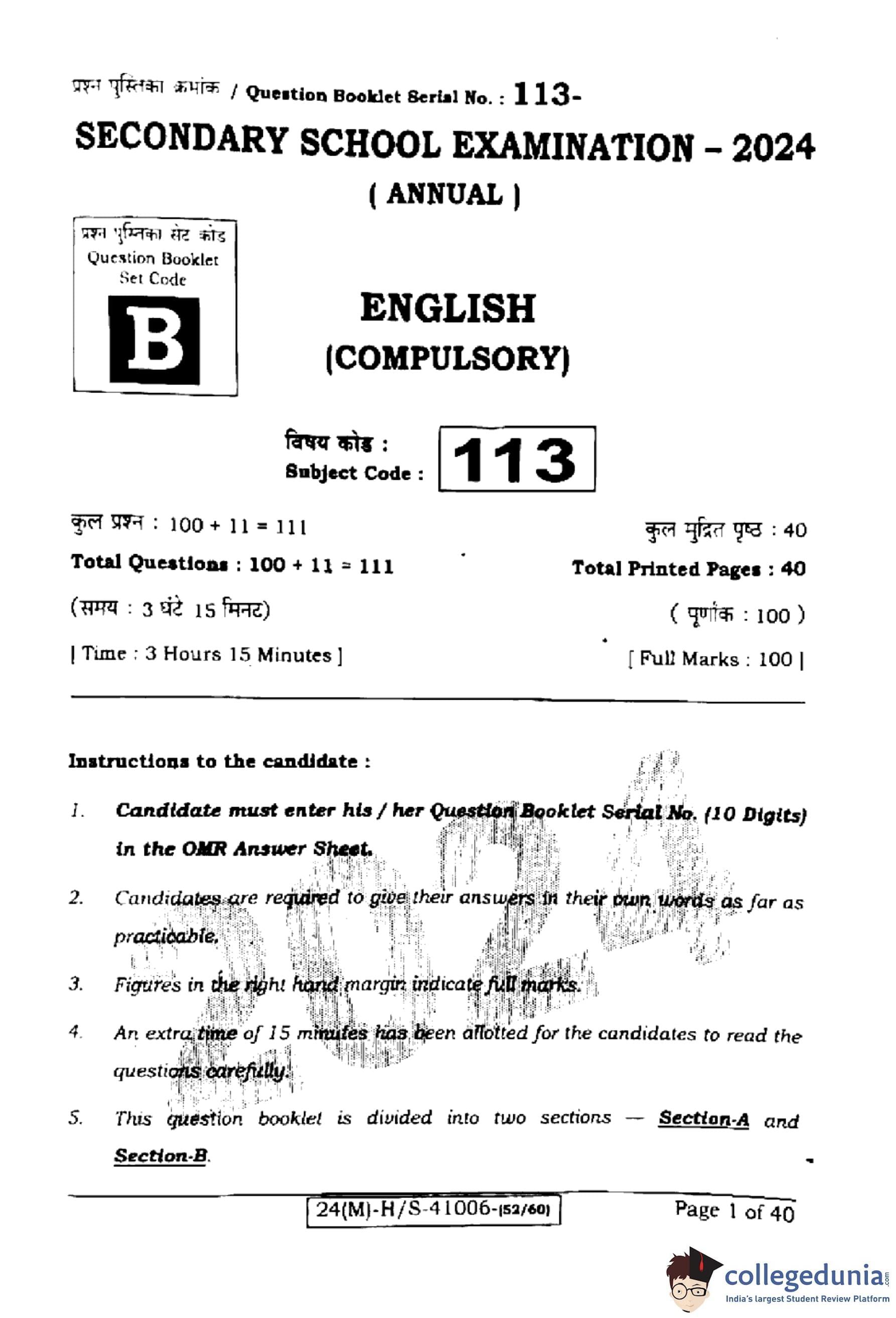

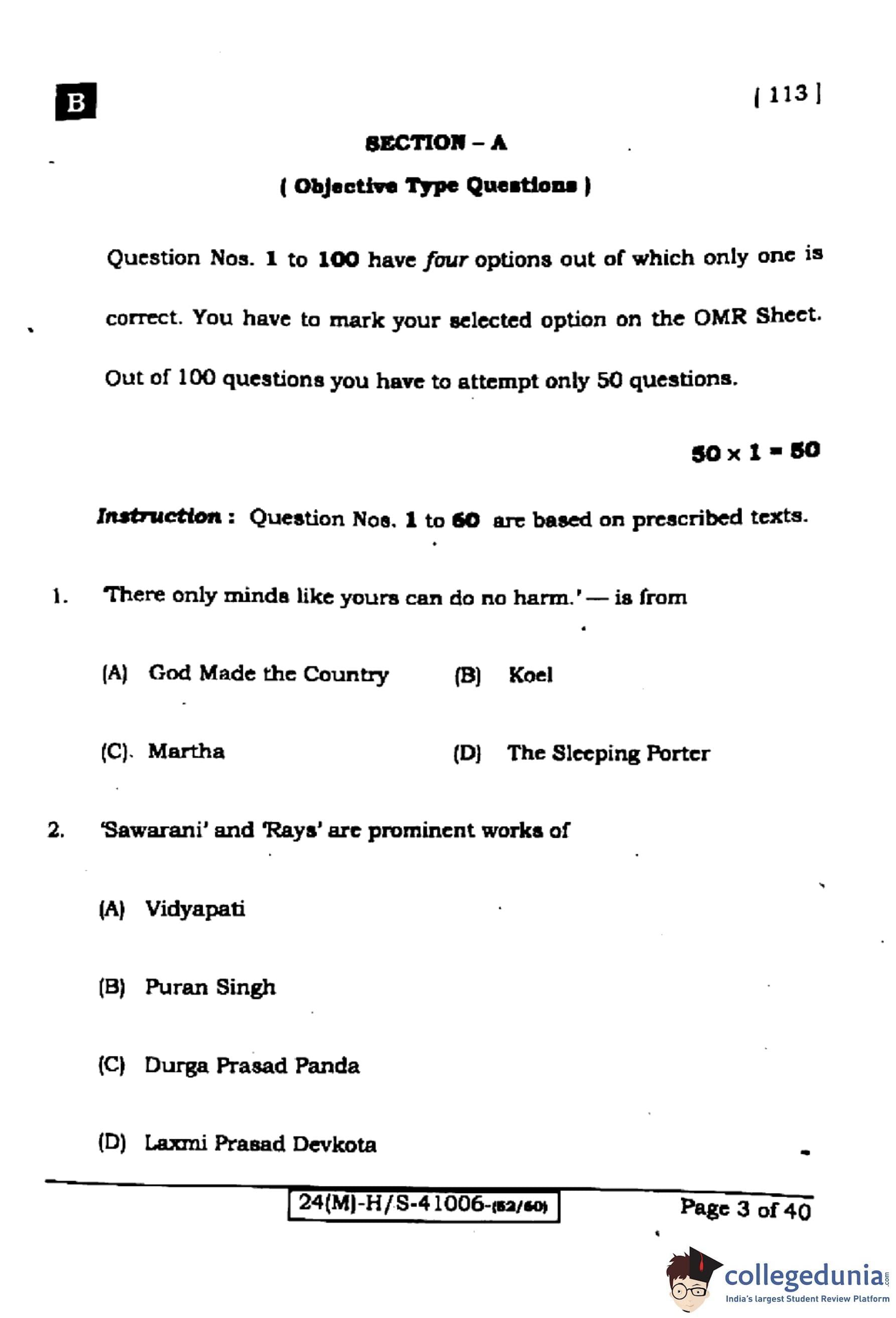
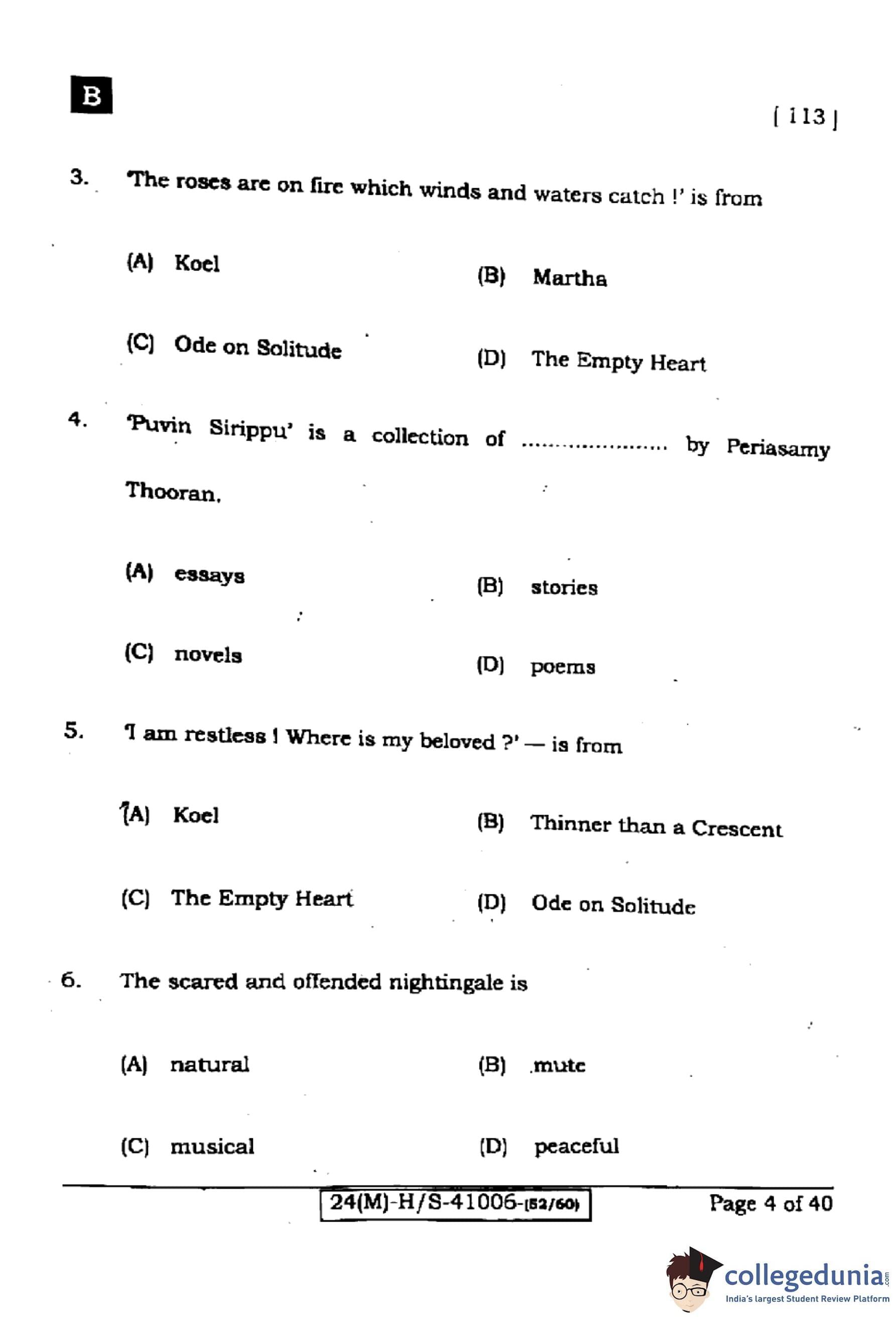
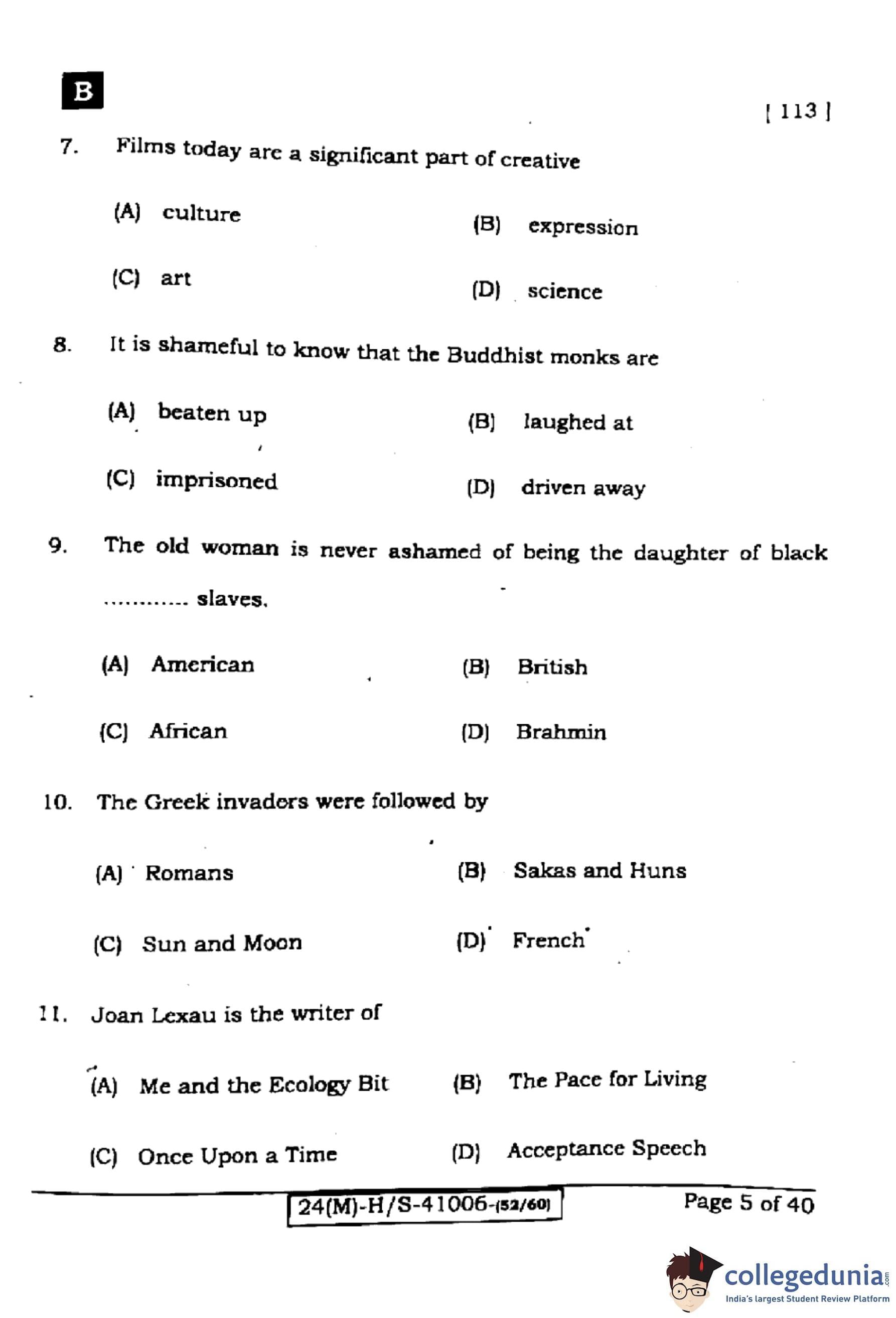
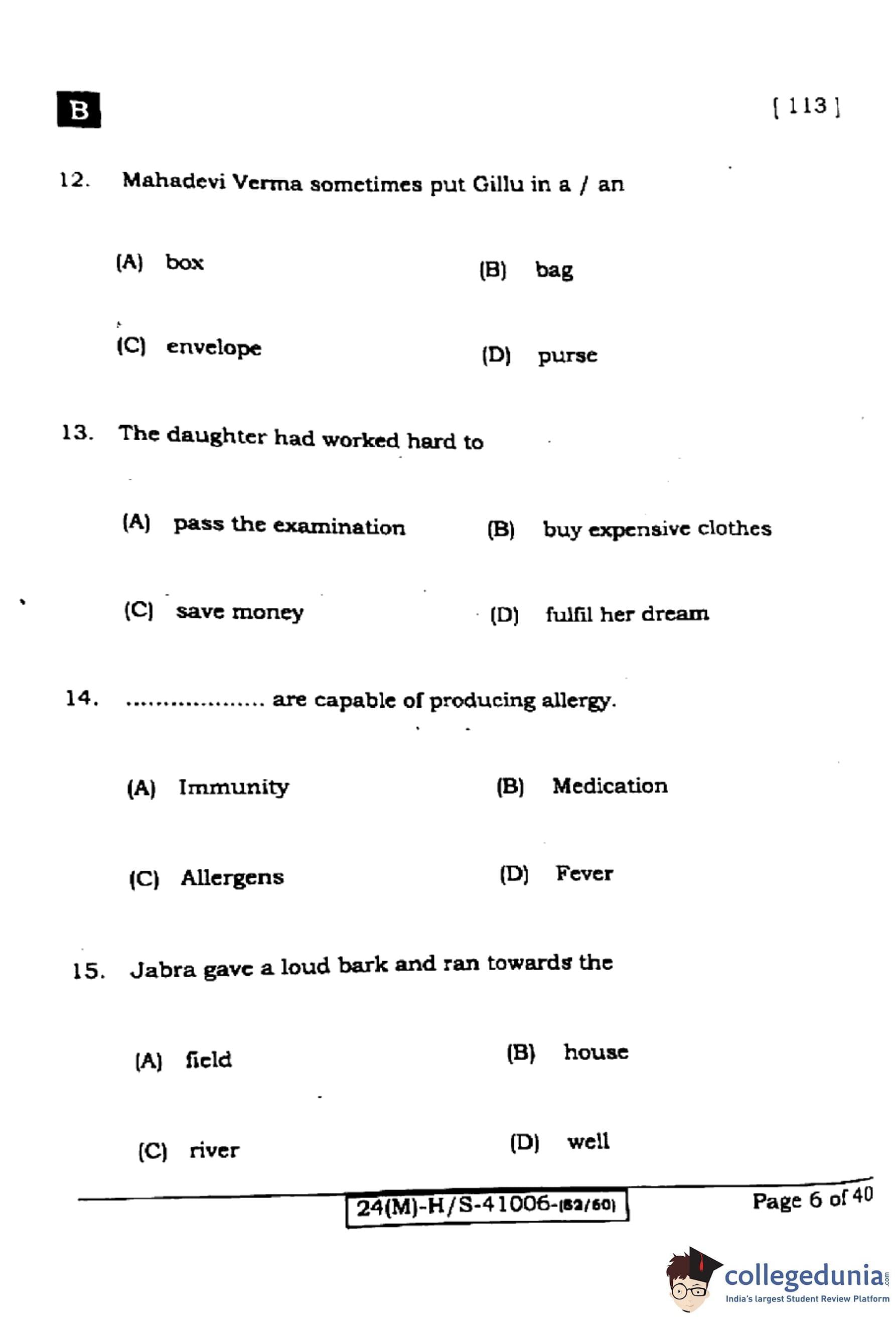
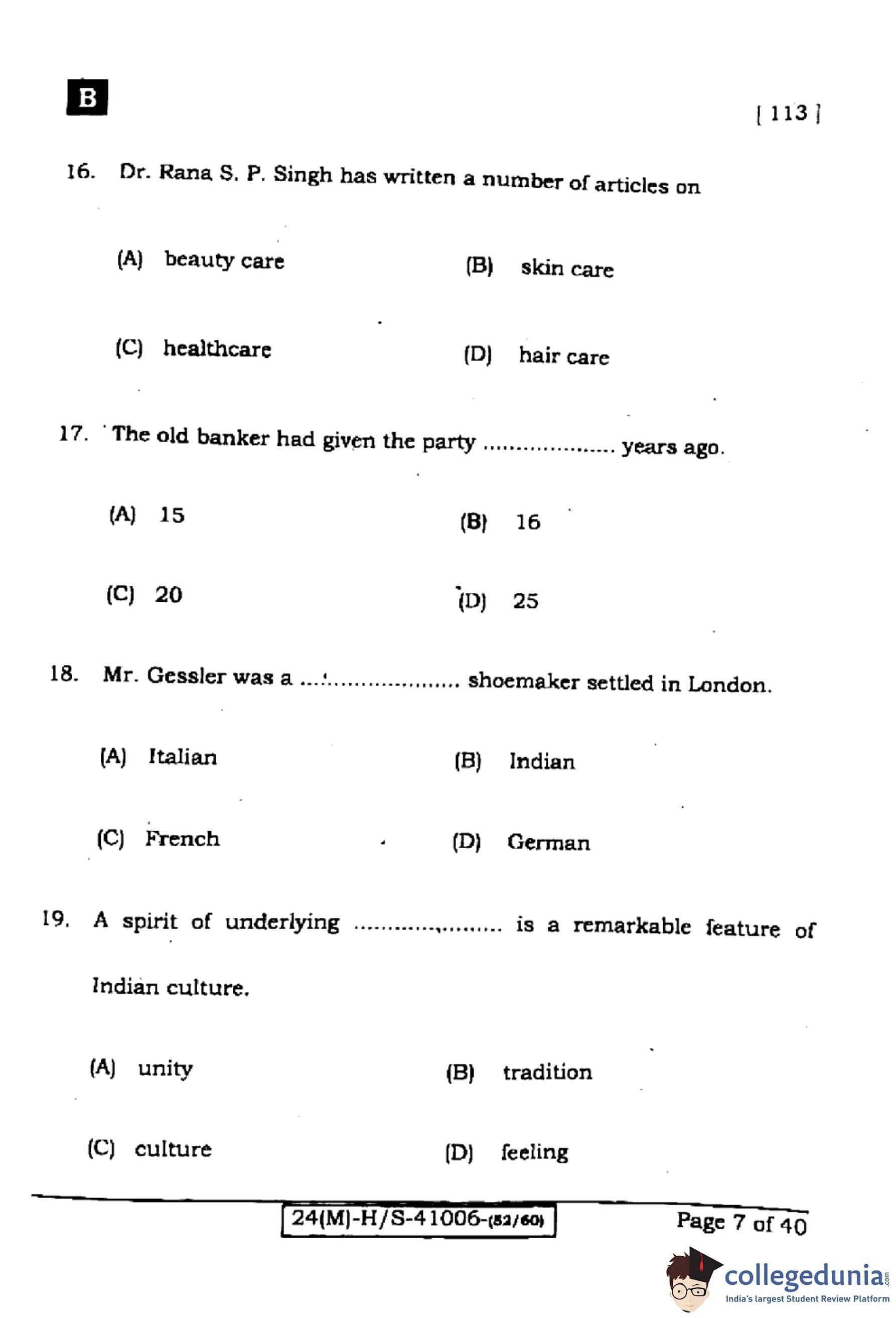

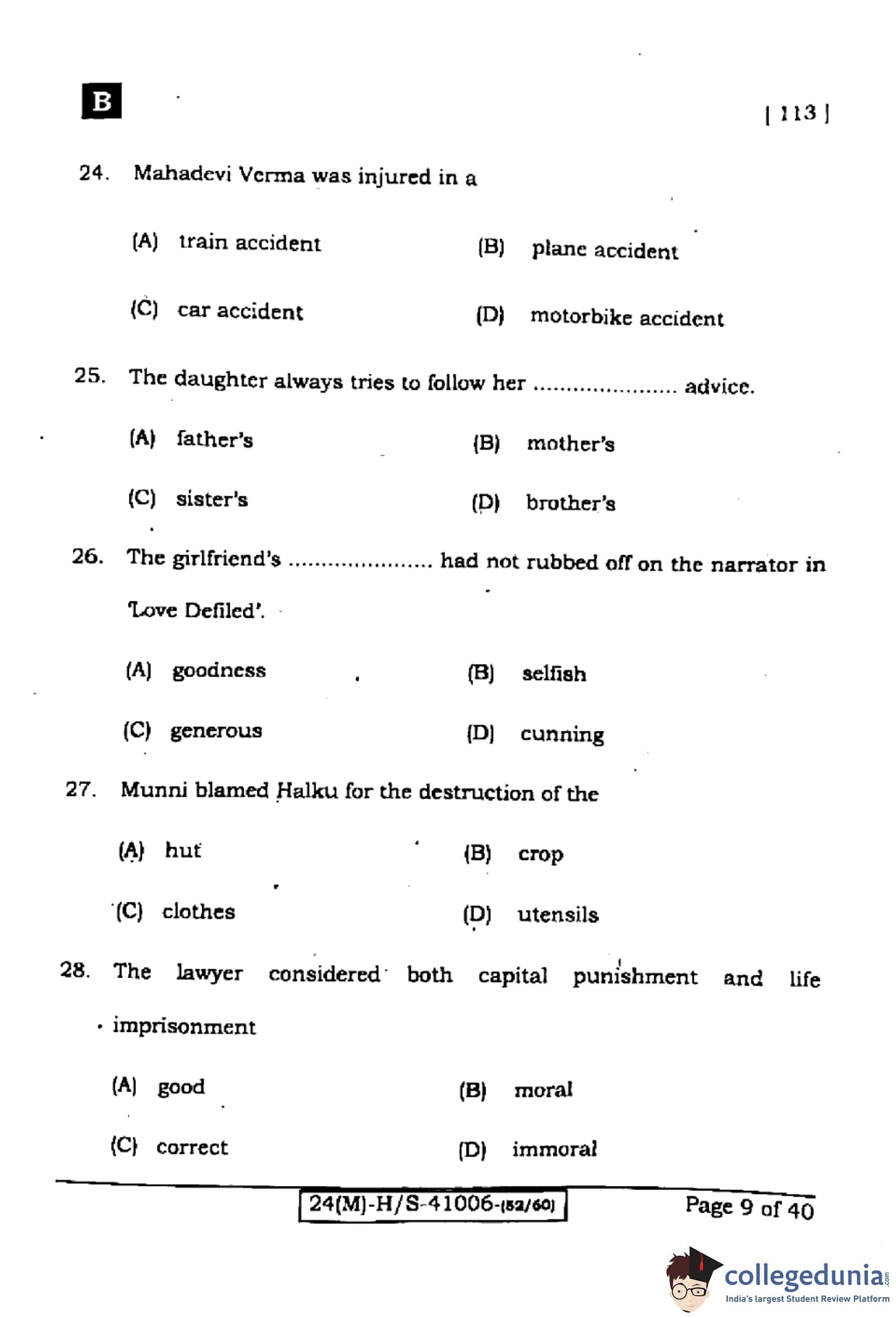
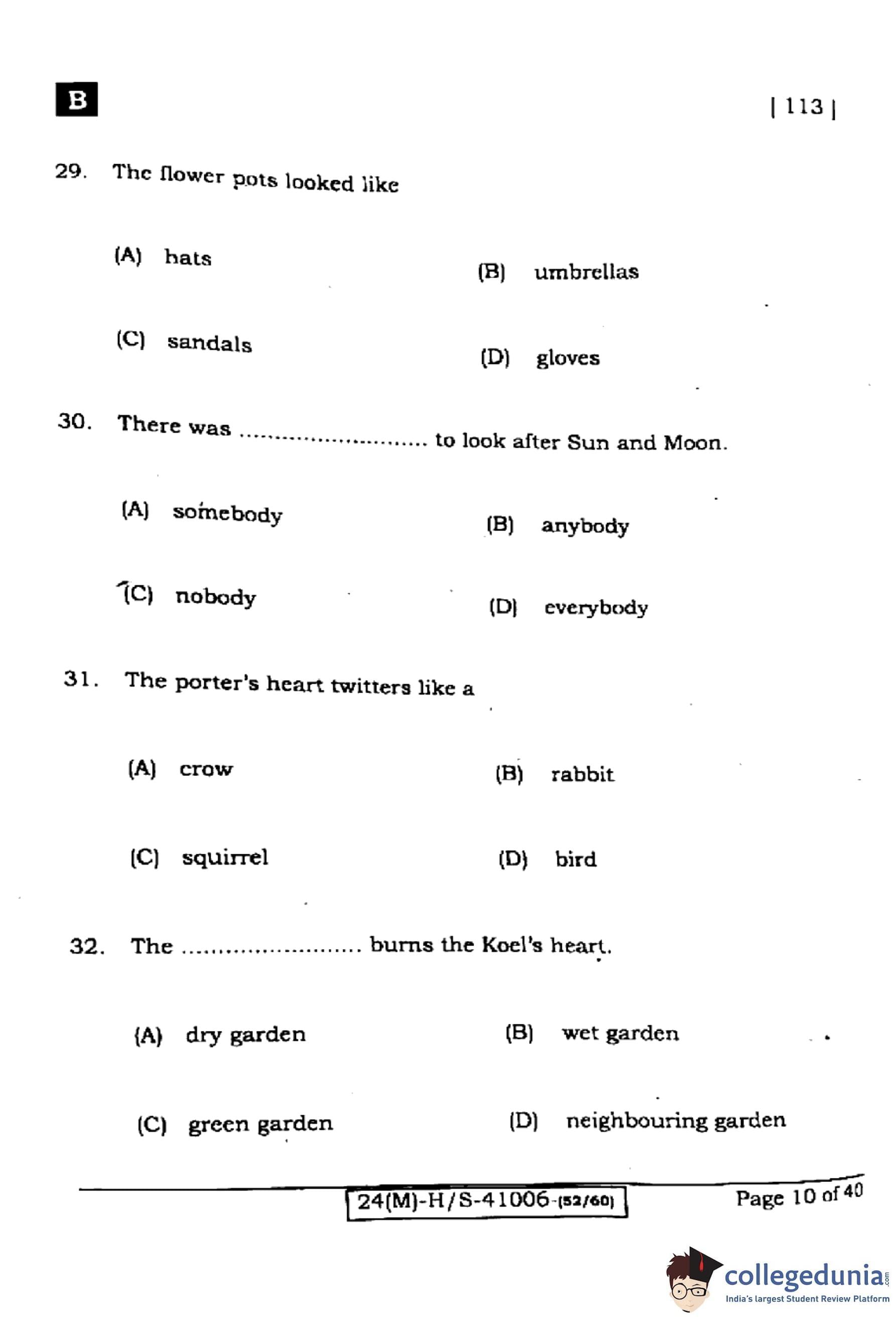
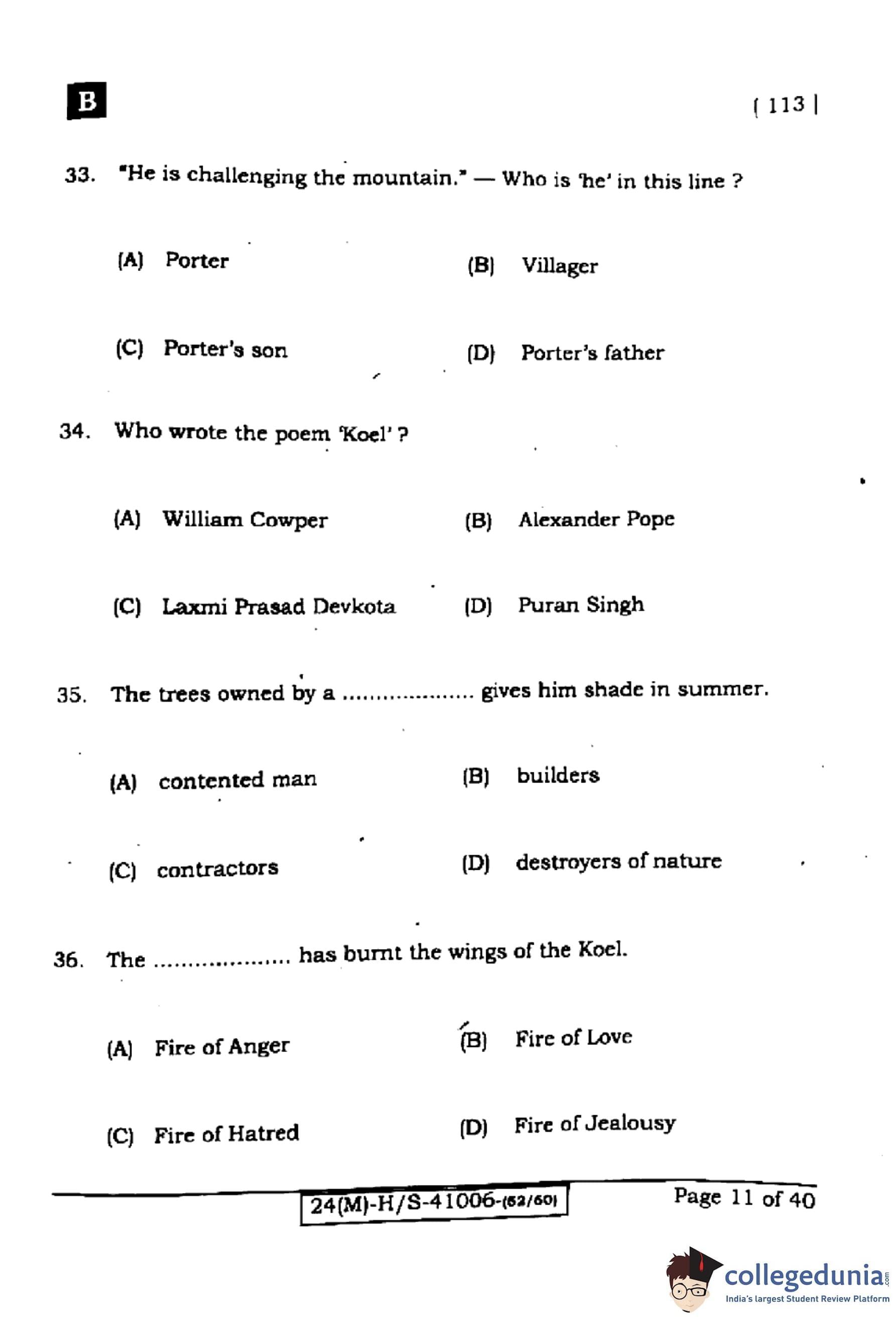
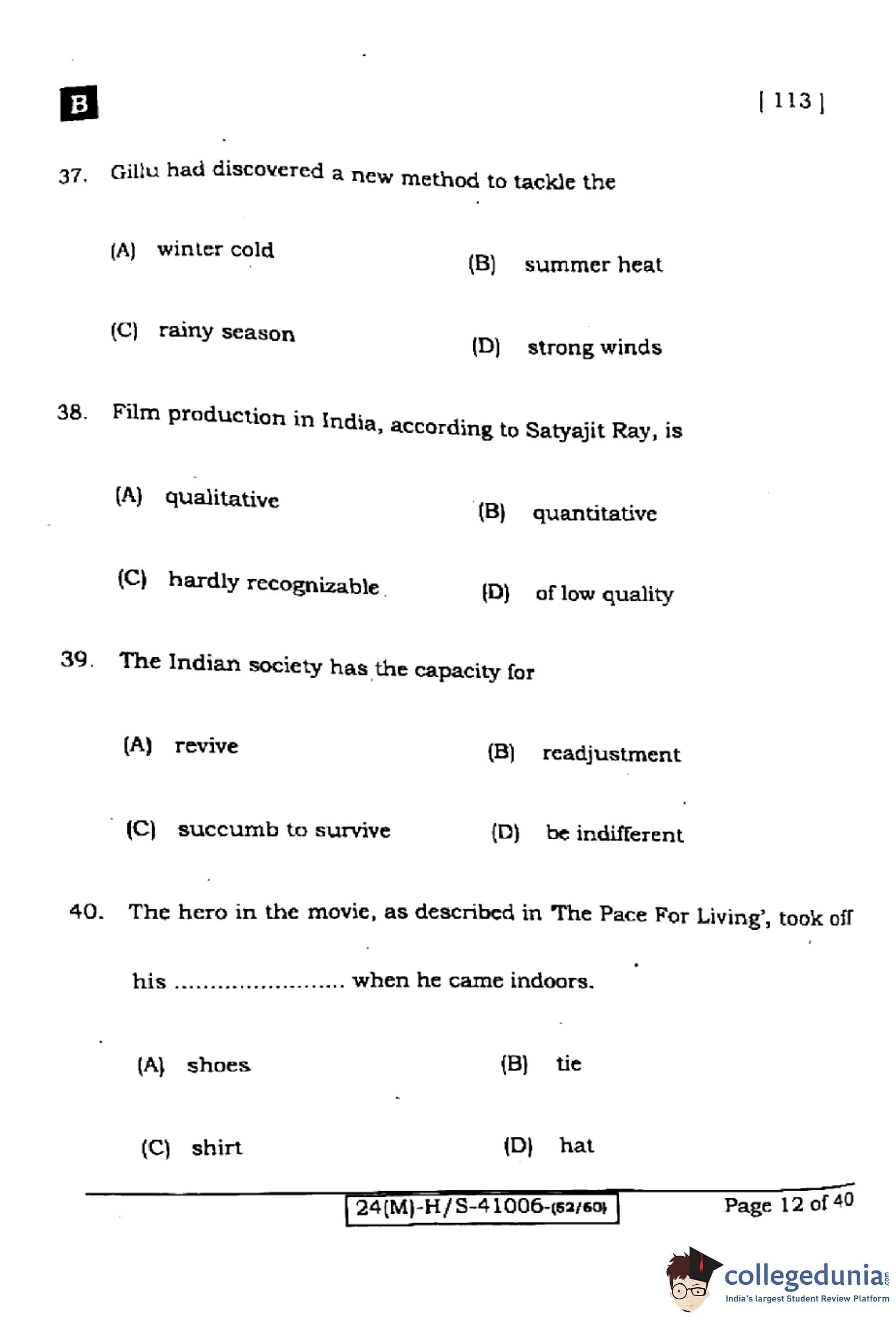
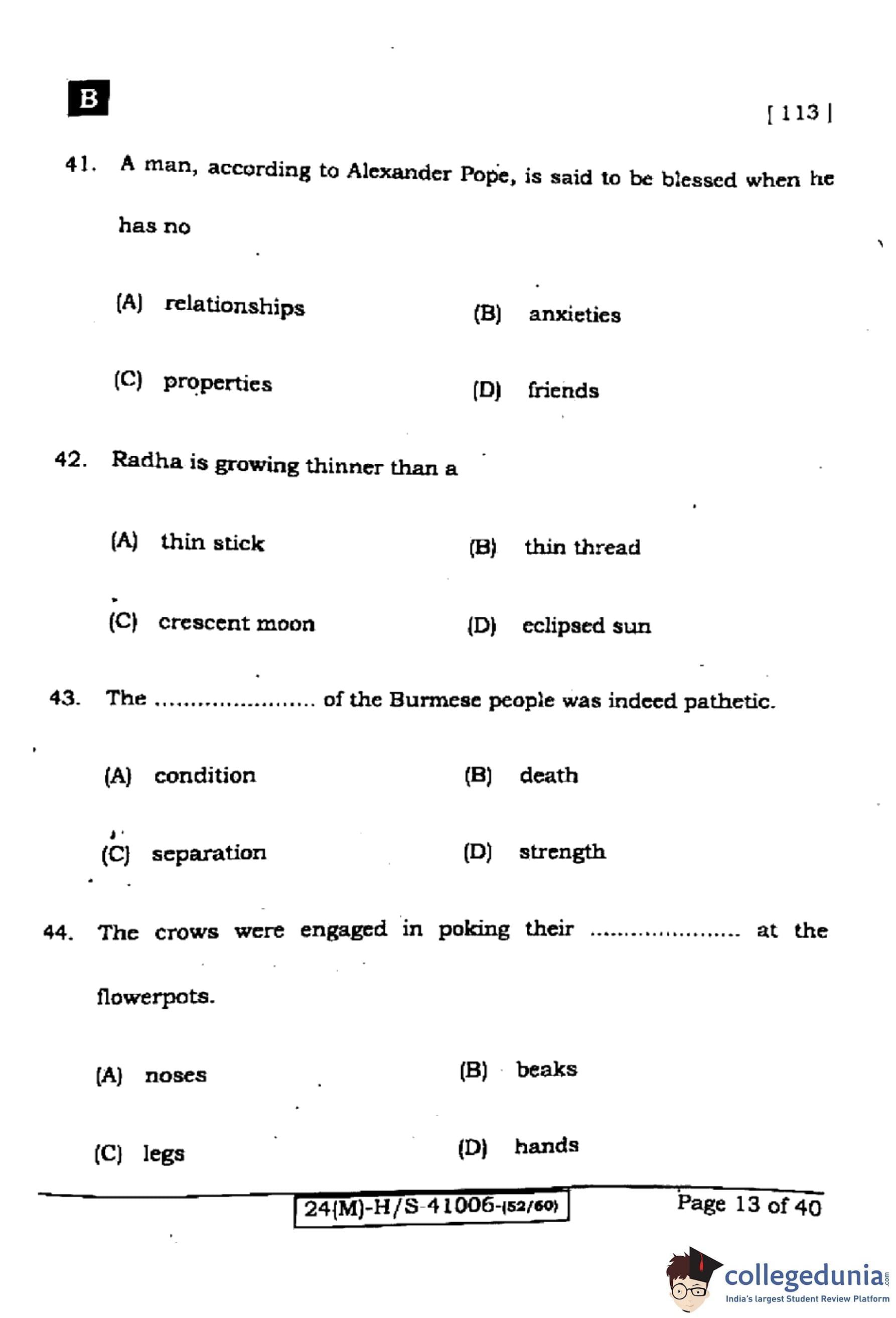

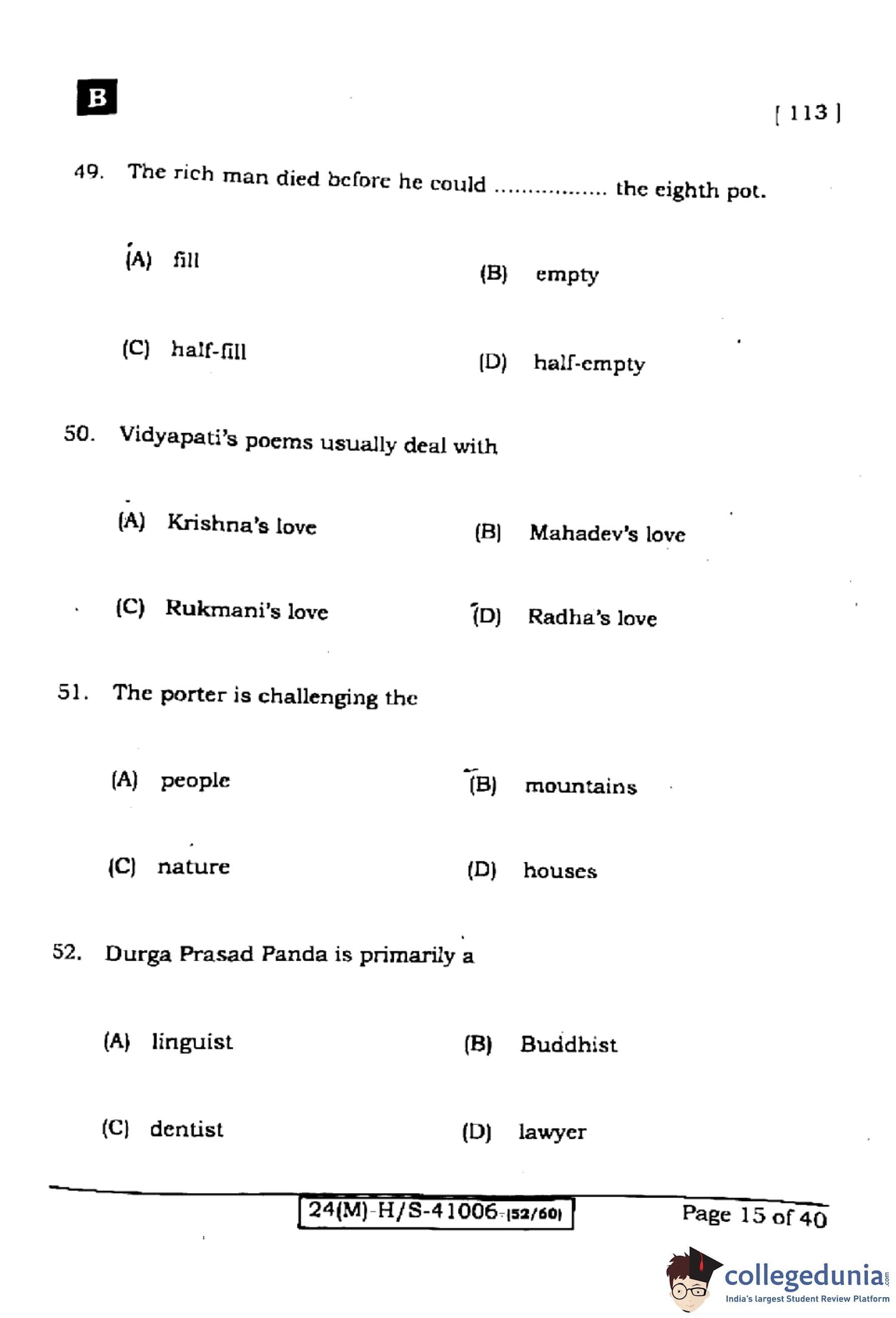
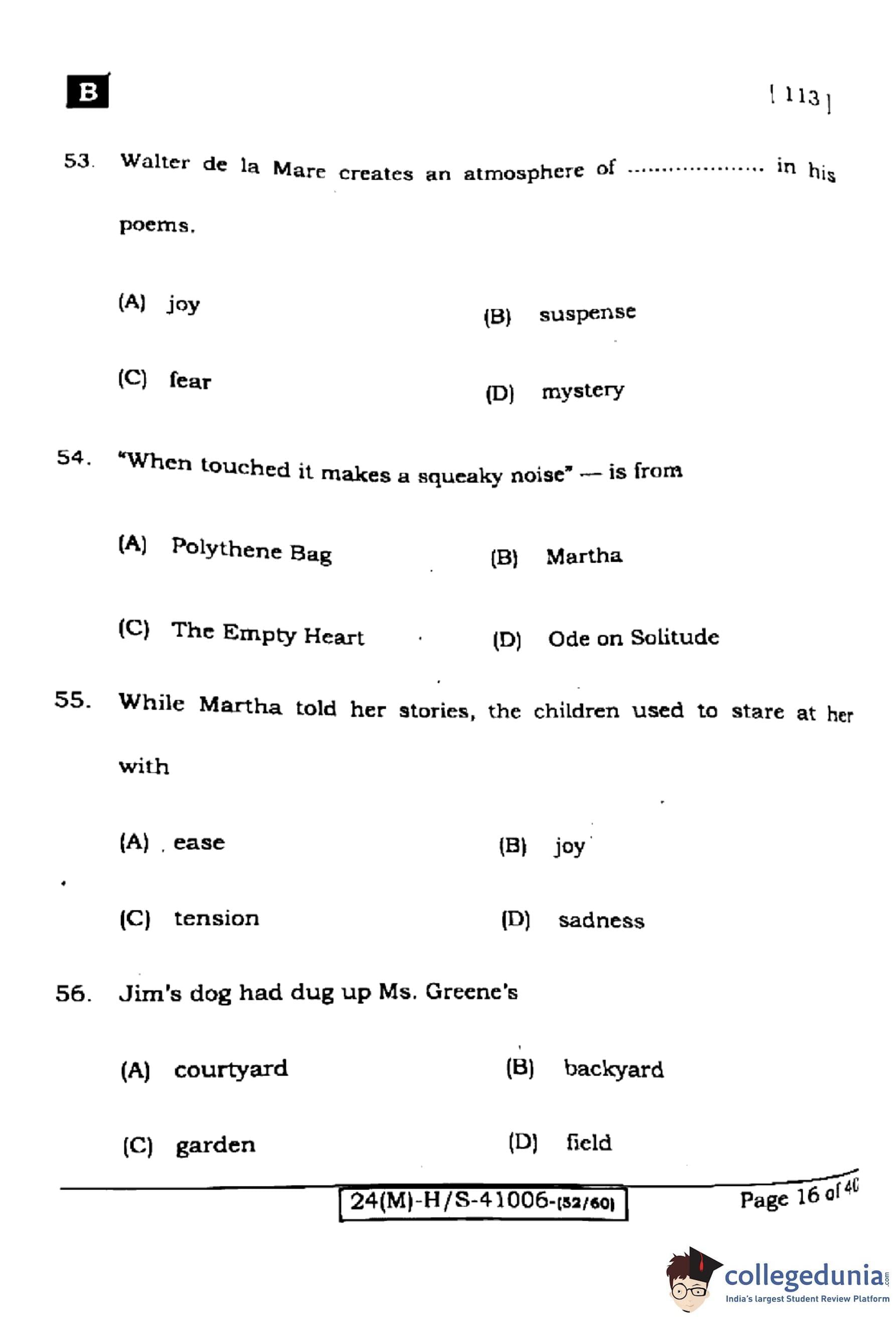

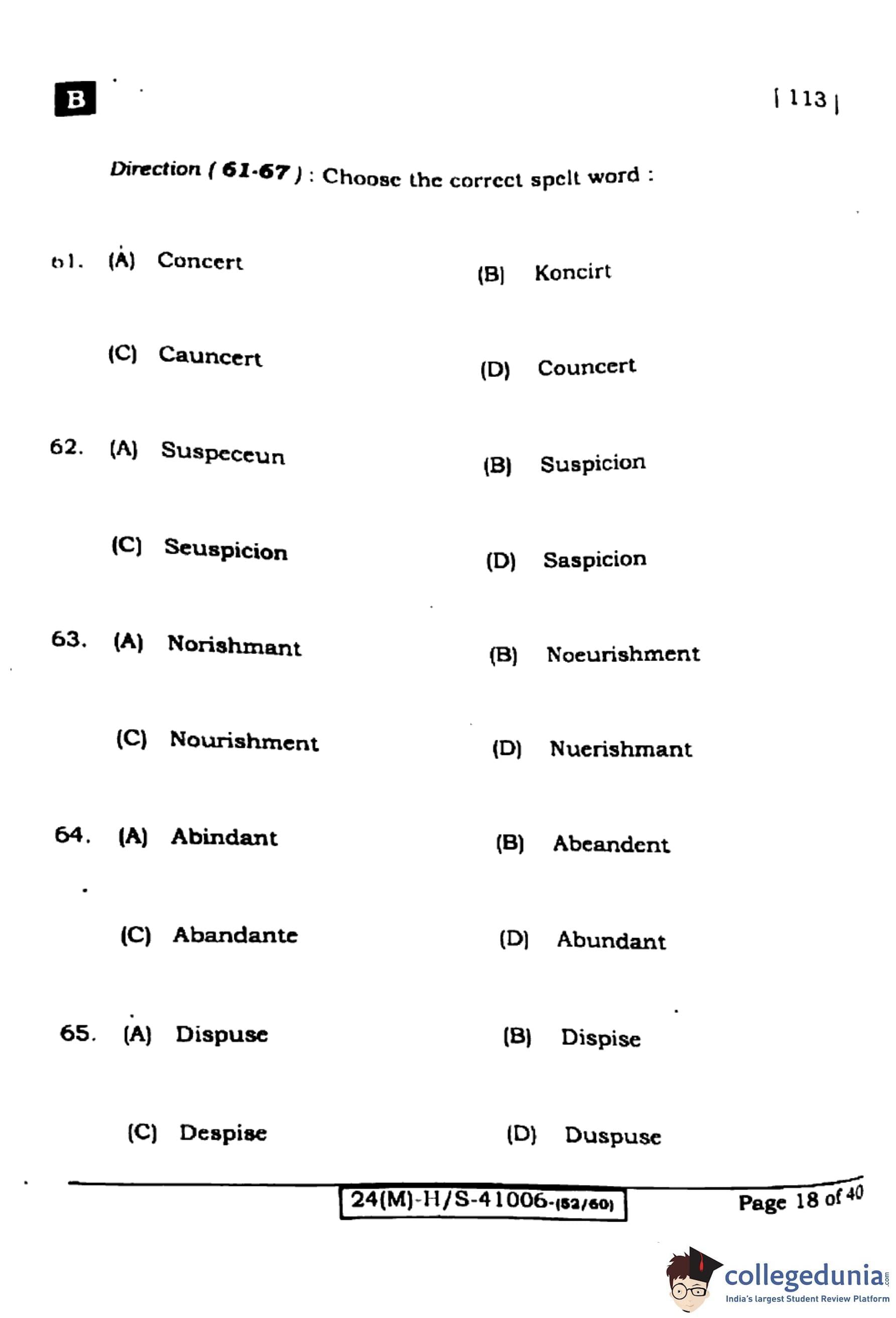
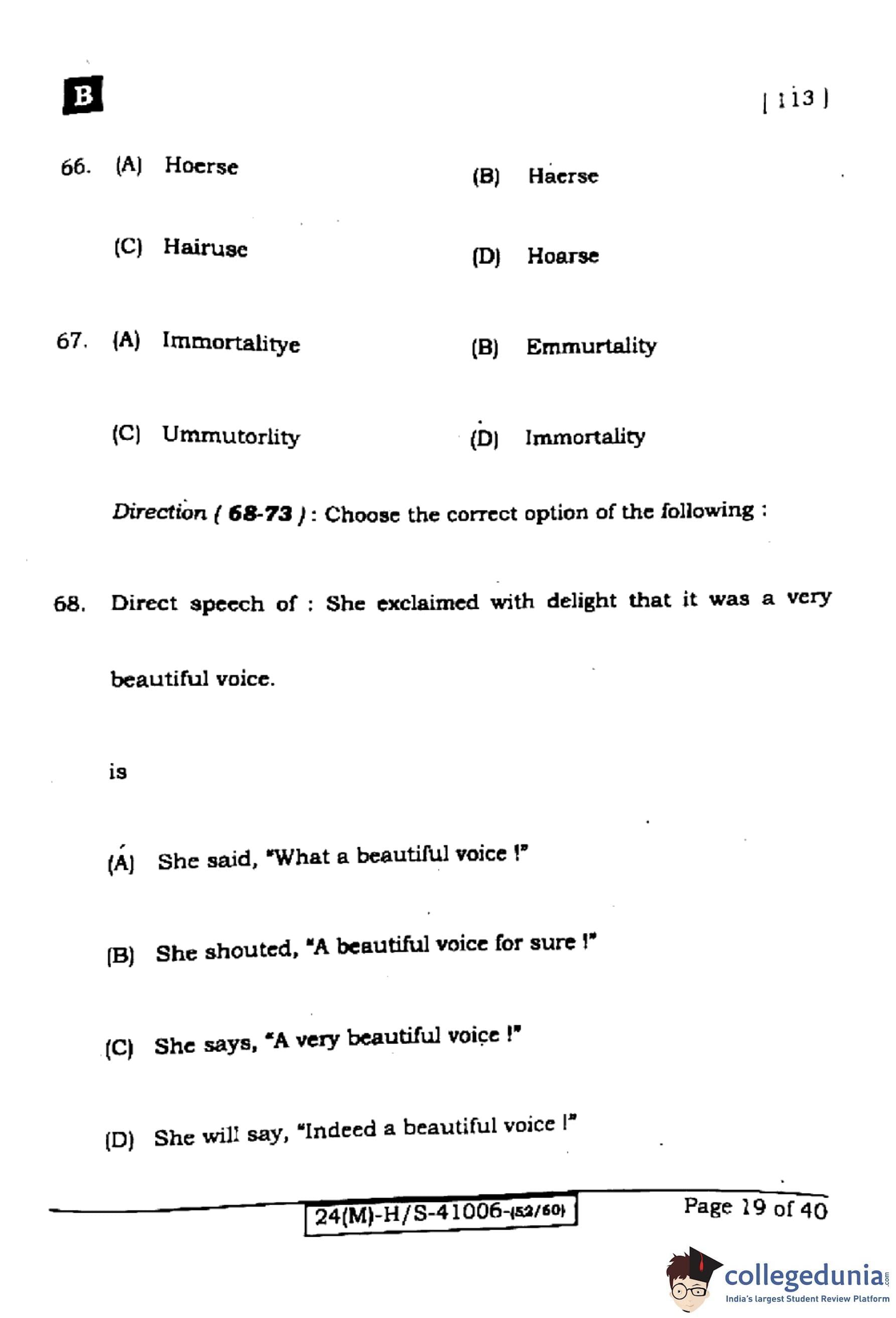


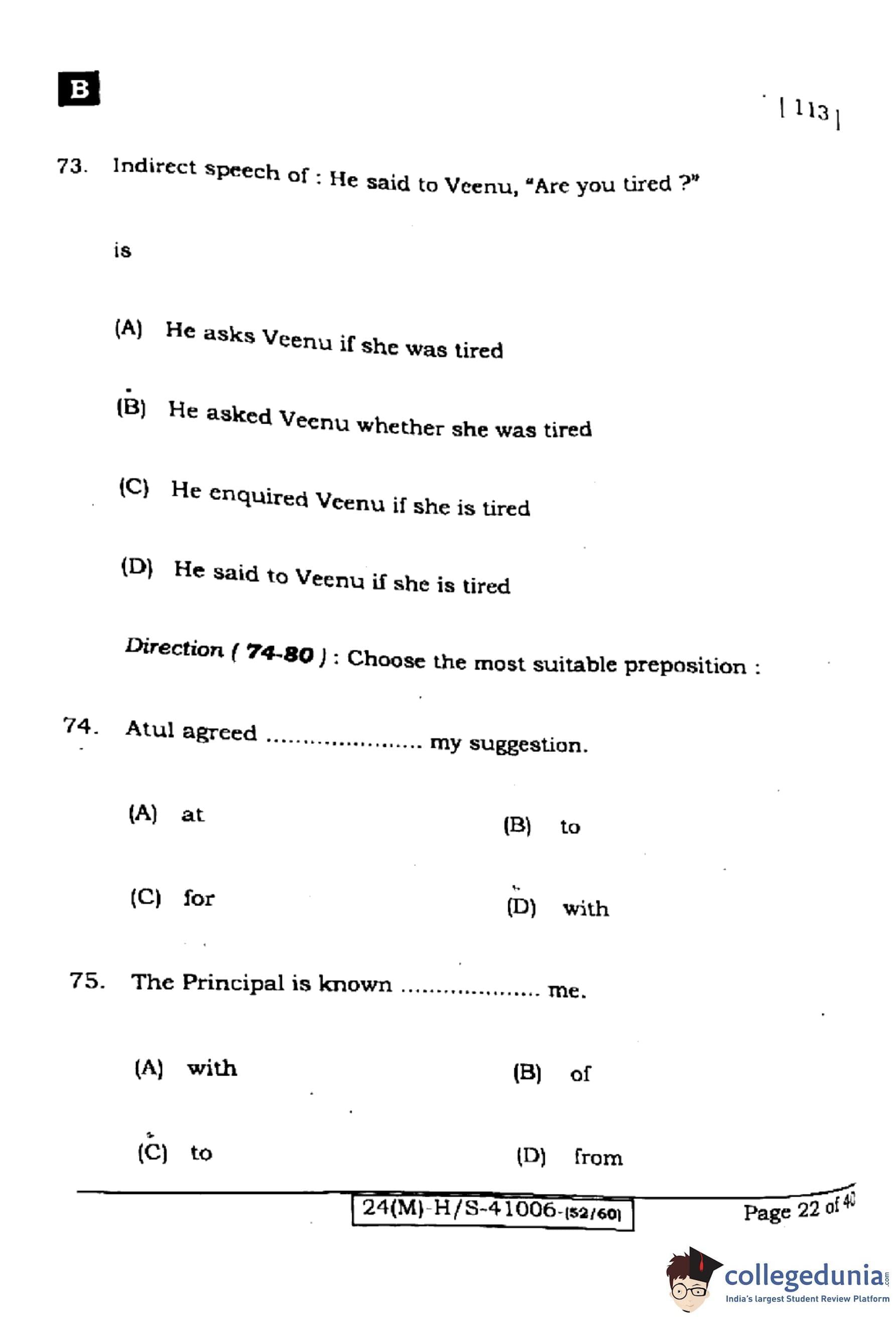
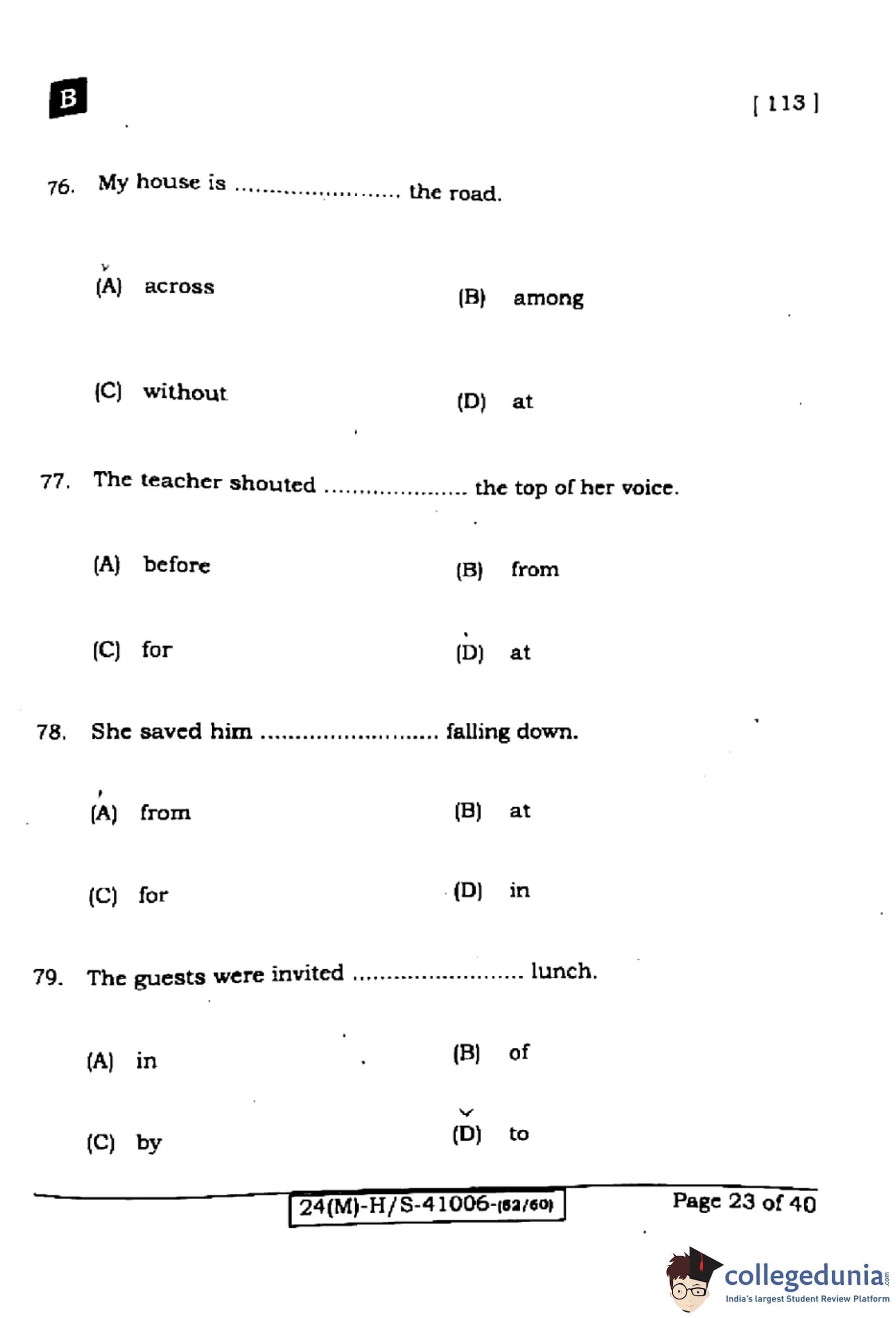

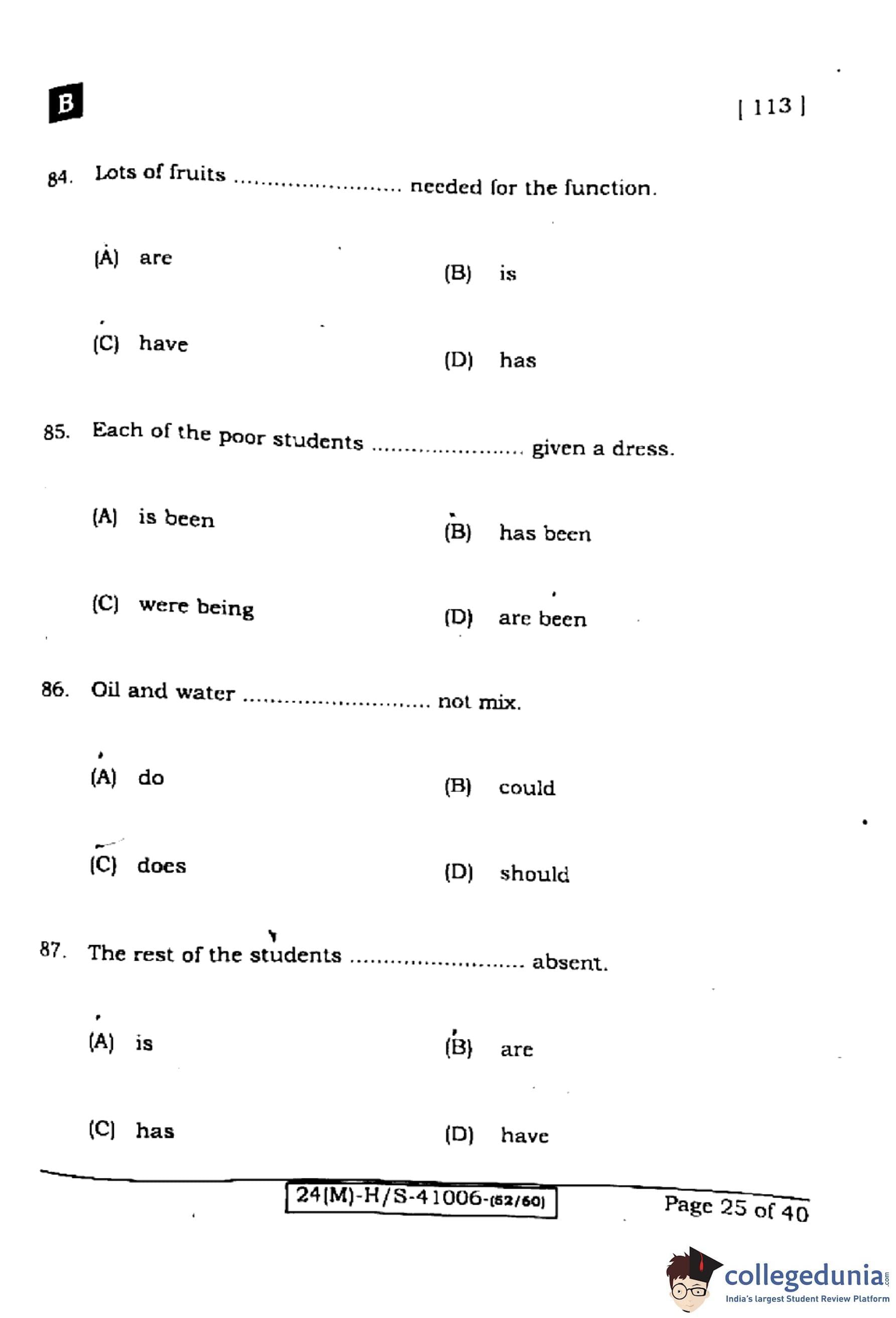

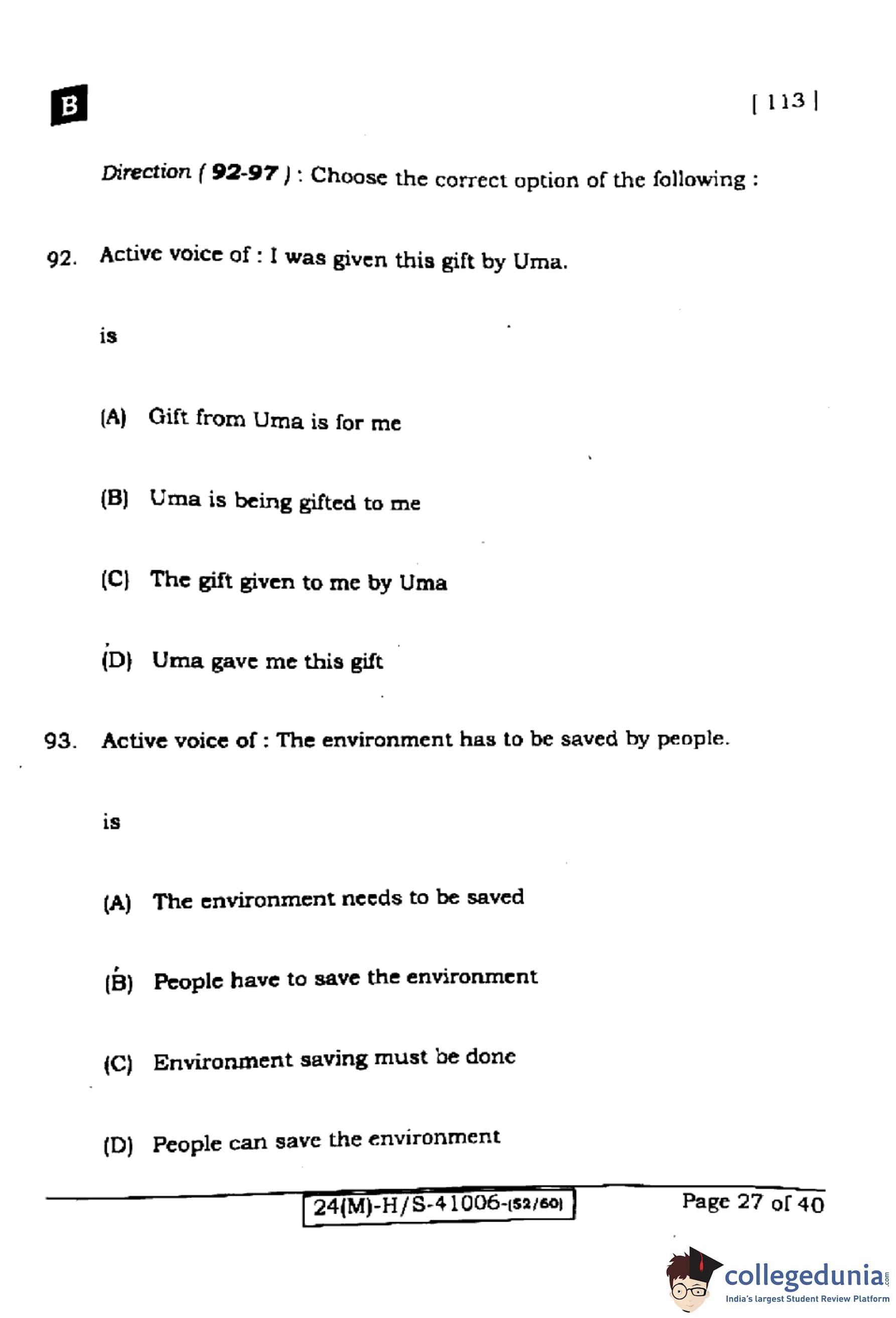

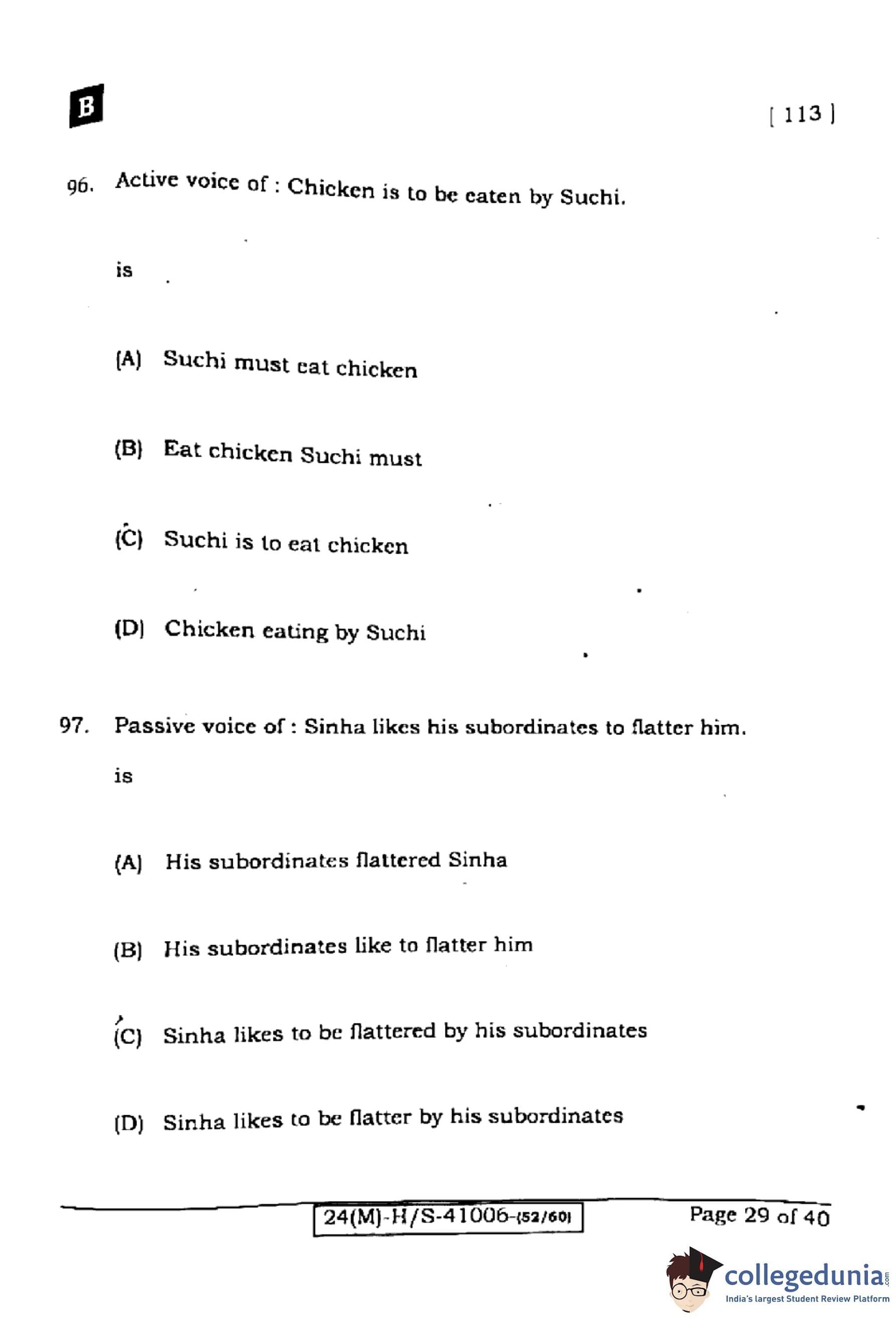
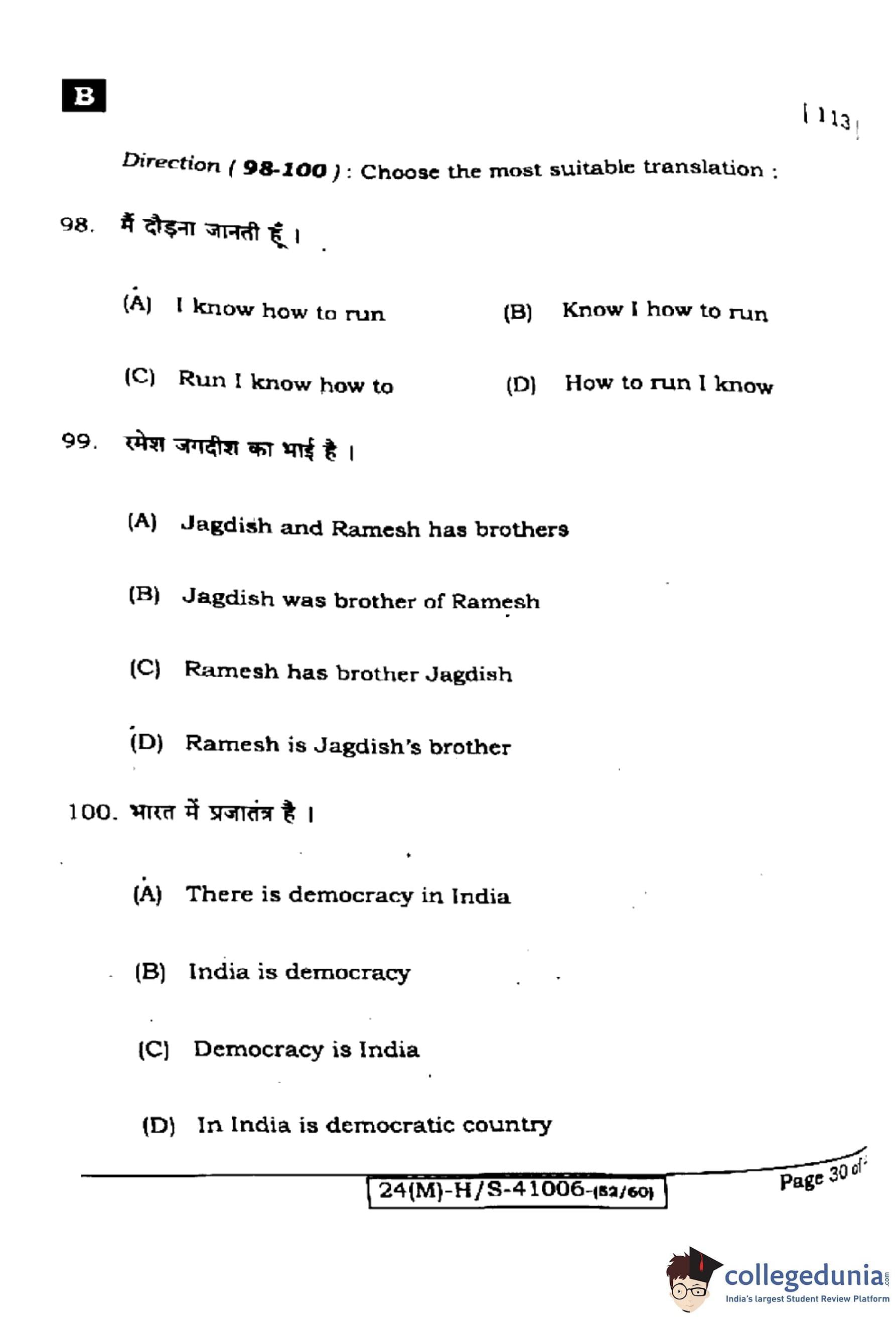
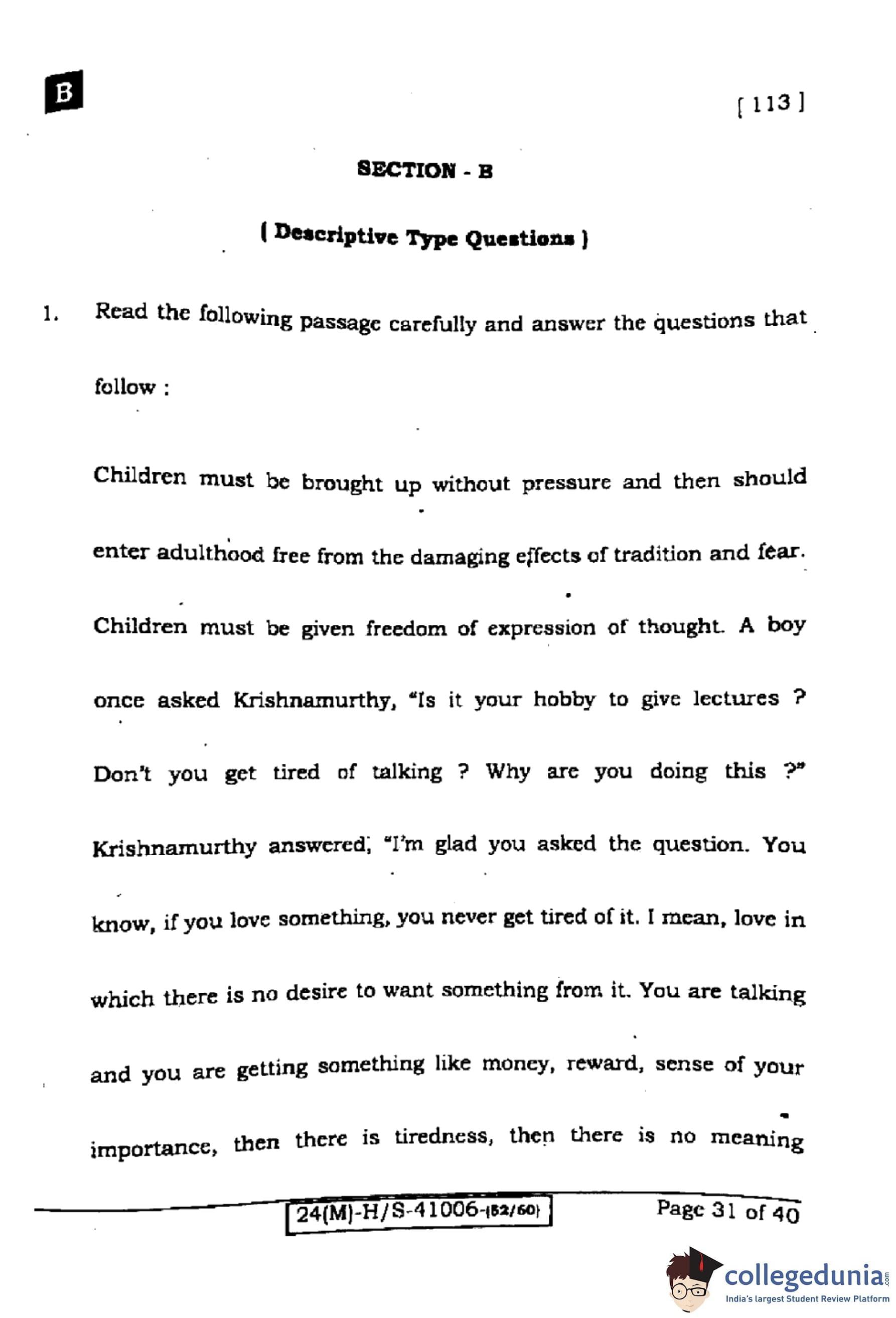
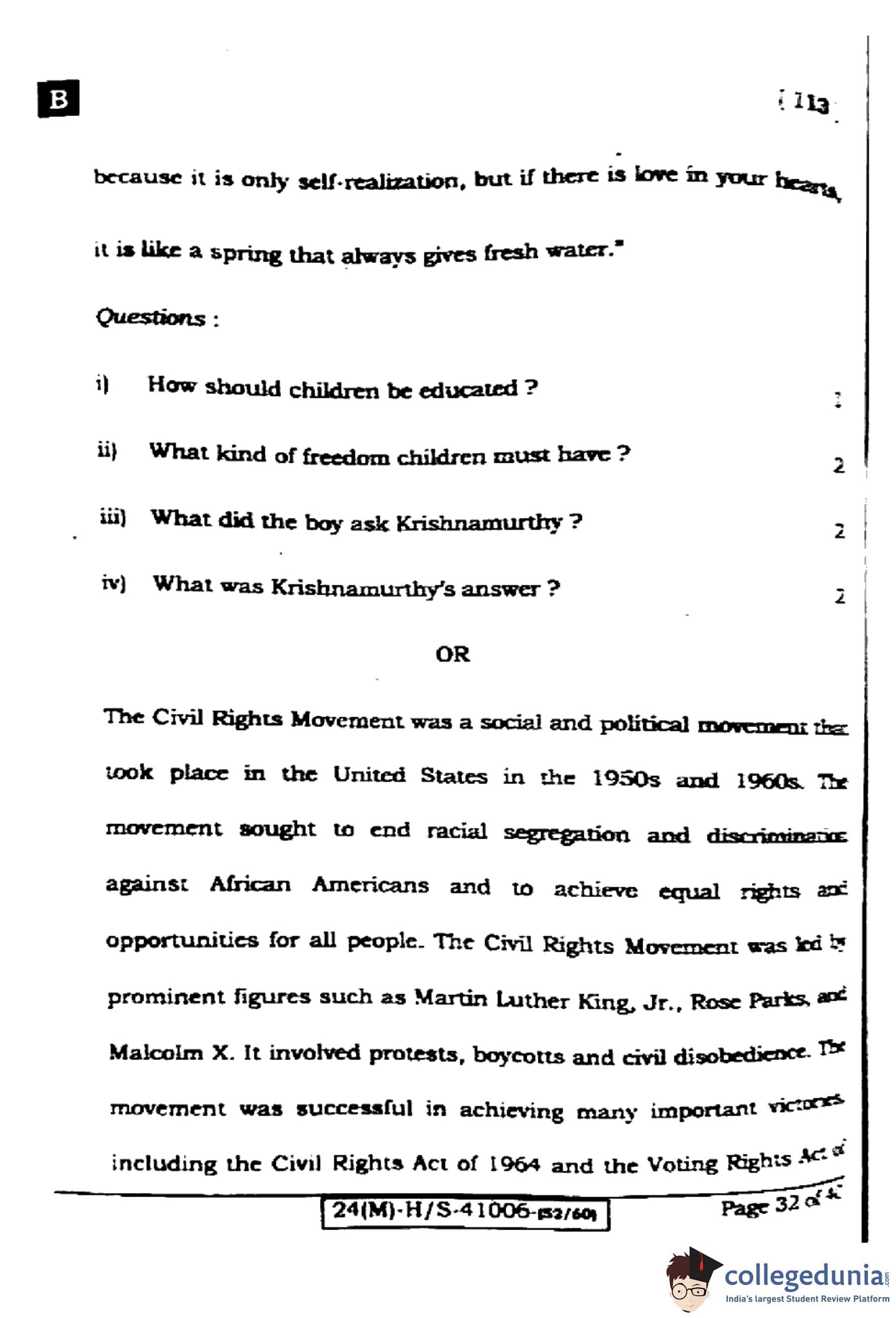


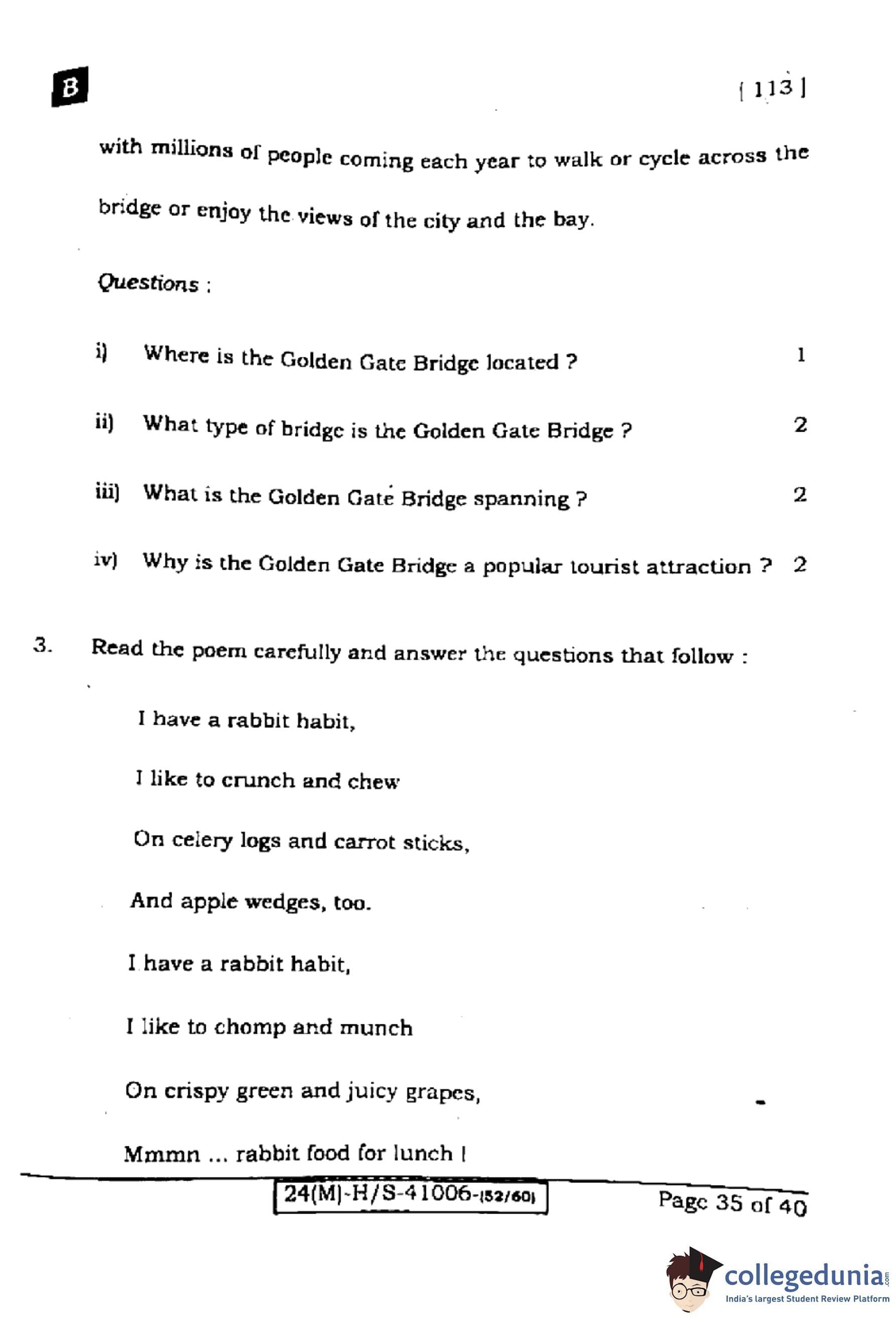
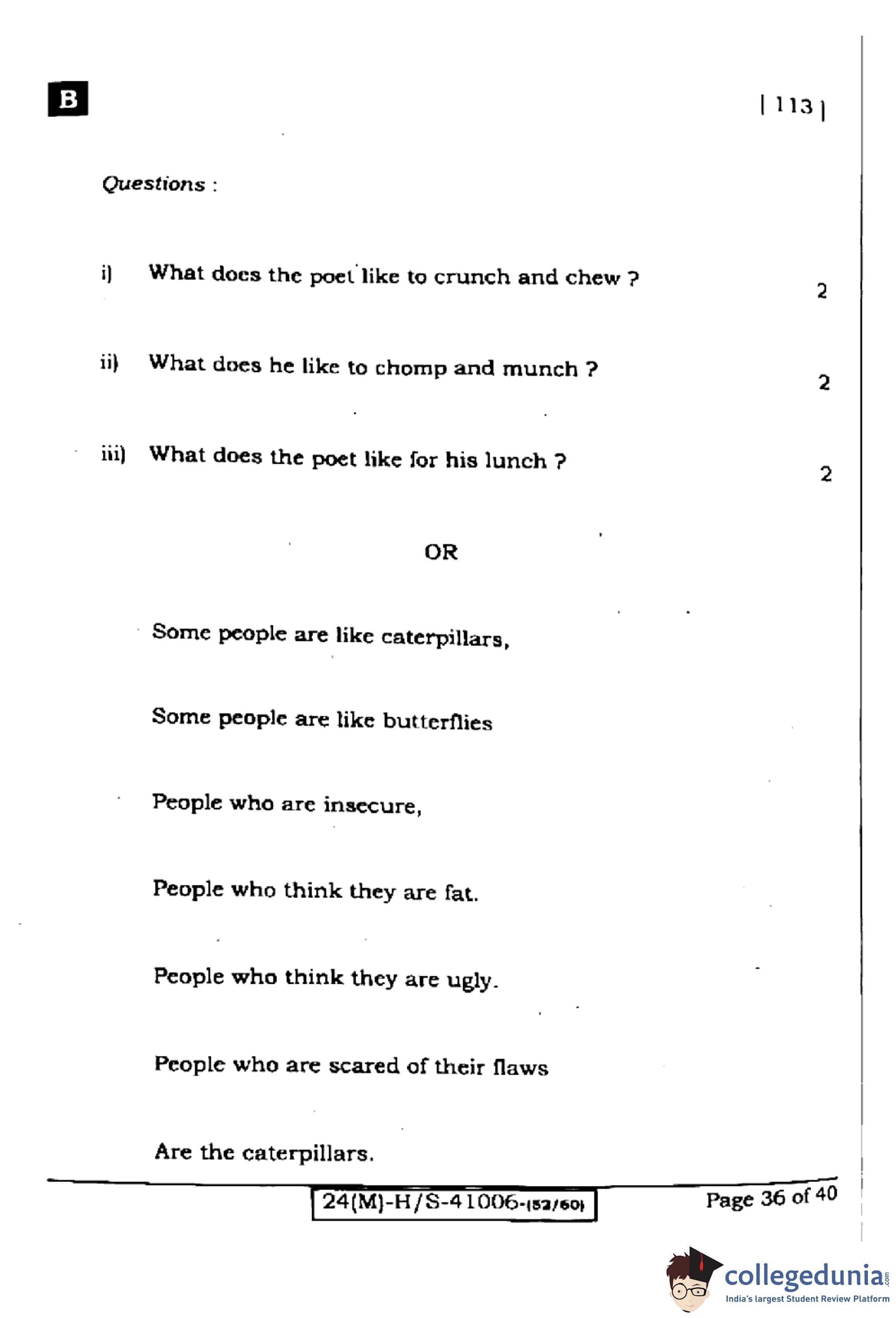
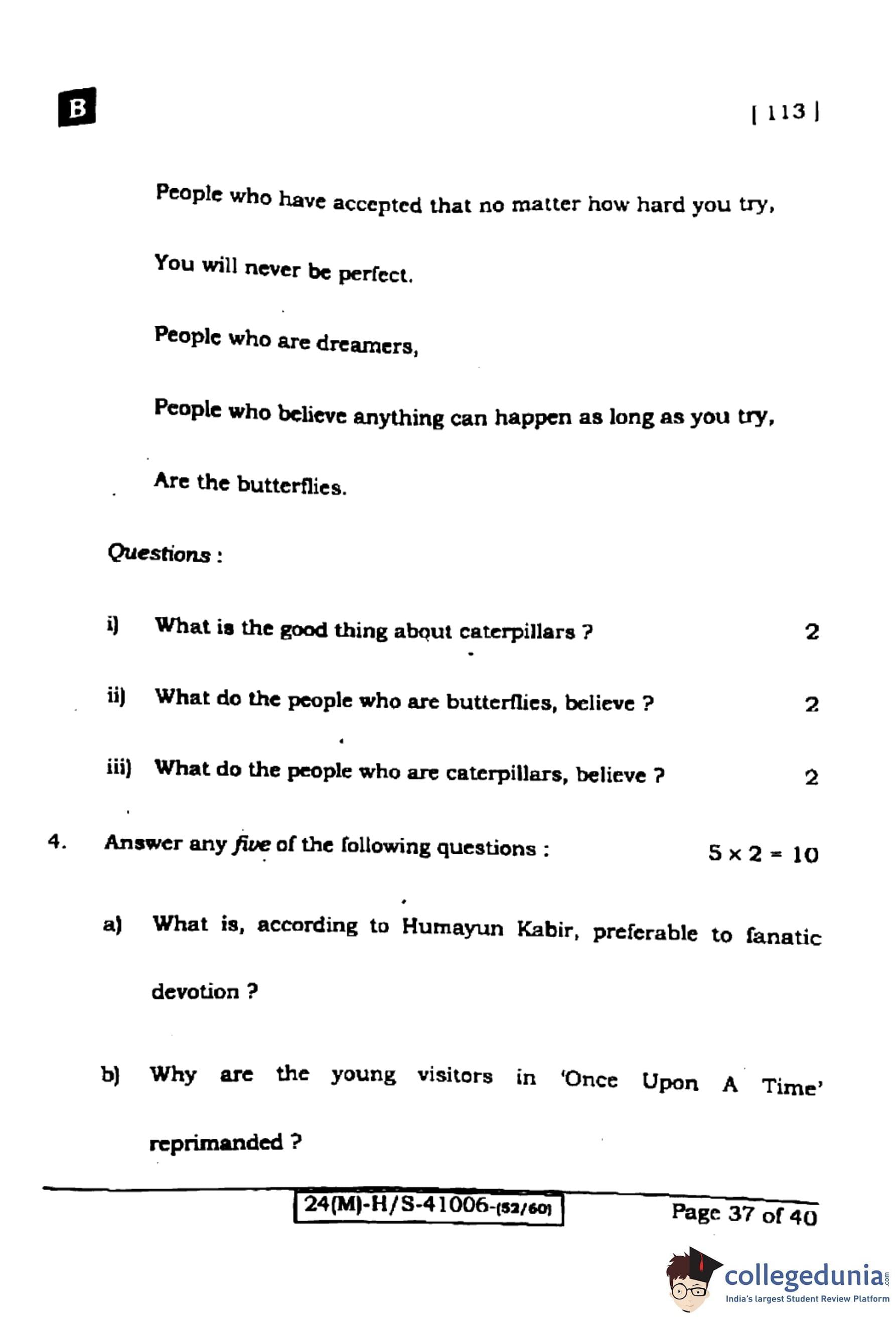
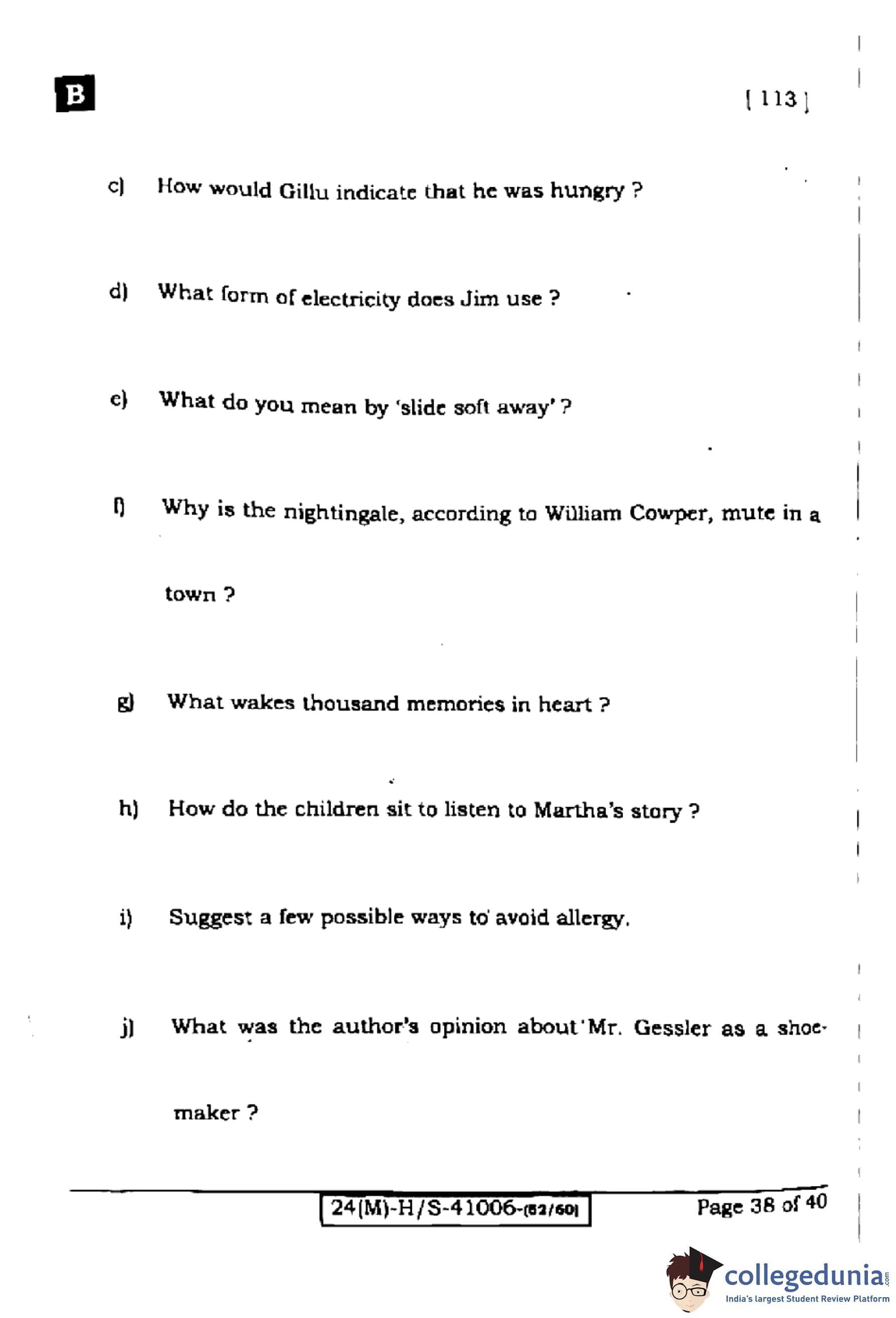
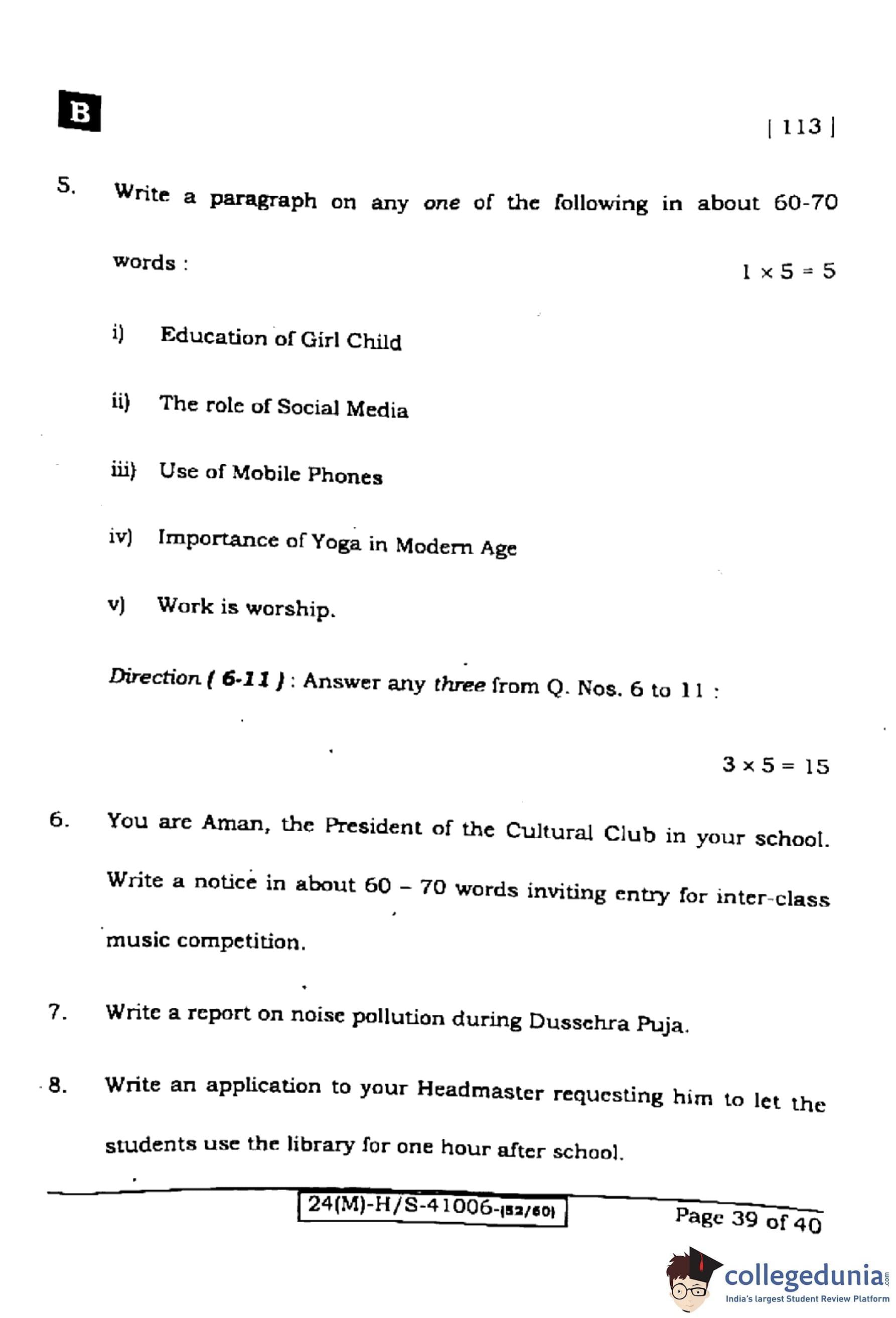
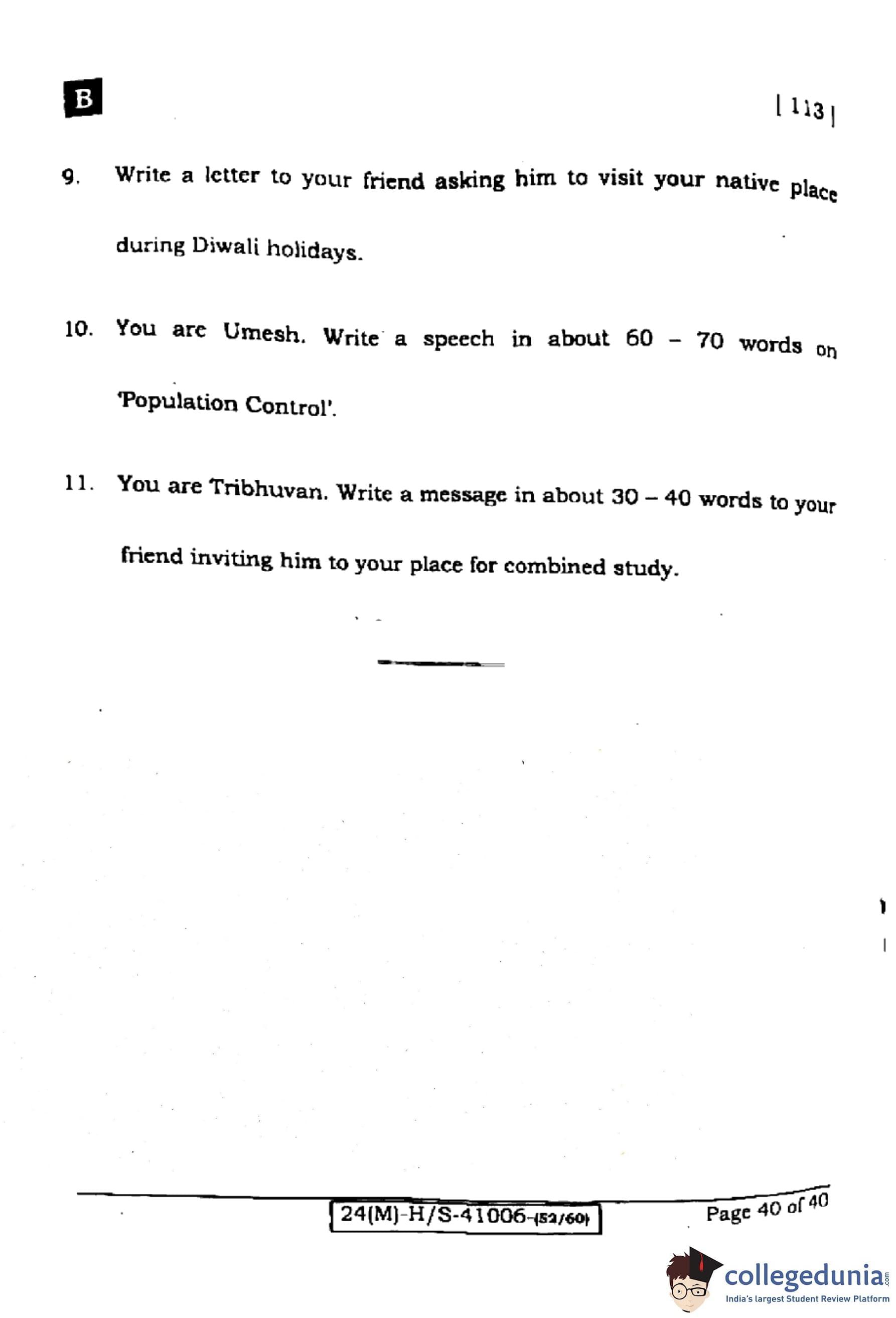



Comments